#the style was popular from about 1870 to 1930
Text


Seem's best friend is a brass crab with no pincers that I got from a consignment shop for $8
#seemblogging#catblr#kittenblogging#suddenly cats#the crab used to be a snuffbox btw#he's probably pretty old#no maker's marks or anything#solid brass#the style was popular from about 1870 to 1930#the fact that his pincers are gone#and the place where they were has been sanded down#(you can see the tool marks inside)#means someone really loved him#and kept him for a long time#even after he was kinda broken#and i think that's great#no idea why seem is so enamored with him tho#but i can't exactly fault her#i love the little guy too
22 notes
·
View notes
Note
Hello! What do you think of the costumes in the drama Nothing Gold Can Stay? ☺️
Hi, I think its costumes are so inaccurate that they're kind of... interesting? to look at. Most of the costumes are standard Qing guzhuang but some of the pieces look like the designer went out of their way to offend history. The time period setting is just brushed off as "late Qing Dynasty" and no particular decade is specified, but considering the historical figure on which the female protagonist was based on, Zhou Ying, lived from 1869 to 1908, this drama spanned the 1880s-1900s.
Nothing Gold Can Stay 那年花开月正圆 (2017)

Source
All of the costumes give me a weird vibe I cannot explain, it's probably the flashy neon colors. First off, standing collars and bangs of this height were not popularized until the late 1900s, when Zhou is supposed to be a middle aged lady and almost deceased. The v shaped gap in the standing collar is a 1950s thing and has fuck all to do with the Qing Dynasty. The cut of all of the women's costumes look late 1900s, though that is most certainly a guzhuang coincidence and not a calculated result of historical research. The progression of time and fashion was not shown at all in this drama, or maybe they did but in whatever made up logic that strays too far from history for me to notice... I feel like I don't really need to watch the actual thing since a lot of the promotional photos capture the wildest costumes.

Source
Late 1900s bangs and clothes.
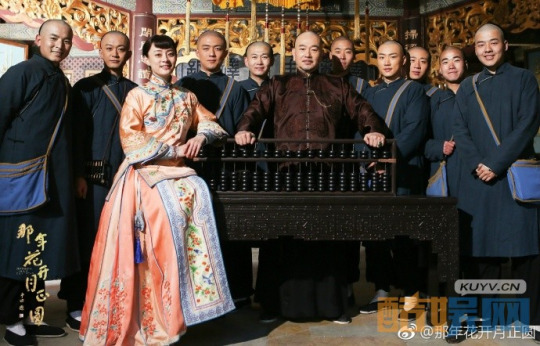
Source
None of the women’s clothes in this show are cut like the 1880s or 90s, they're way too tight fitting and the standing collar is way too tall. The 裙门 qunmen or center section of the skirt looks like it’s a separate flap from the rest of the skirt instead of just the unpleated section of an otherwise pleated skirt?? That probably came from misunderstandings regarding the structure of period mamian skirts. The short length and tight fit of the robe/shirt makes the whole outfit look like a 1910s aoqun, but then the robe has the flared but small 1920s sleeves...
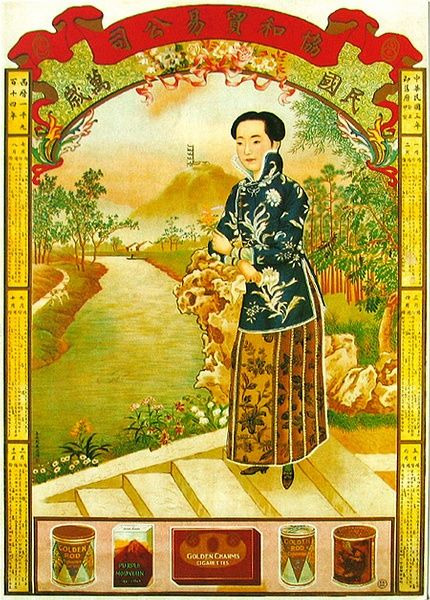
Source
Mid 1910s aoqun.

Source
Actual 1870s/80s fashion, the cut of the clothes are extremely roomy and generous.
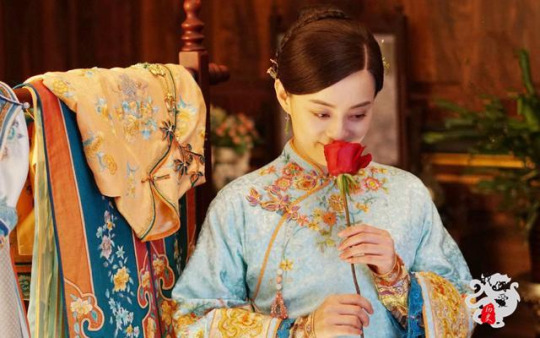
Source
This is a classic mistake where 1950s construction techniques are used on costumes for the Qing/Republican era: the binding at the neck seam is forgotten, the dajin is curved instead of angled, and the collar has a huge gap down the front. Besides weird construction, I’m also extremely confused by the choice of fabrics and embroidery.

Source
1950s cheongsam with this kind of construction.
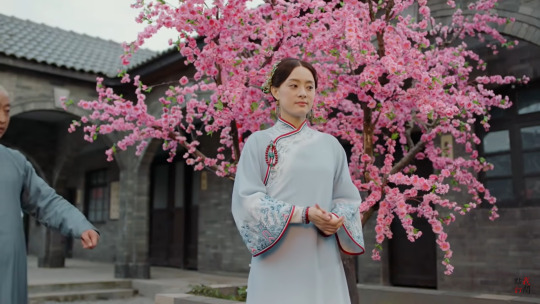
I think the “highlight” of this drama is definitely this dress (yes it is a one piece dress), this floor length 1950s cheongsam-1920s robe mixture abomination. Nothing in this form has ever existed in history and everything about it hurts my eyes. Not to mention the width and style of binding is a very common style on commercial 21st century cheongsam, cheap and not historical at all.

Source
1920s flared sleeves.

??Why does this robe have a gradient border?? The closest thing I can think of is early 30s cheongsam with multiple rows of binding, though it’s peak anachronism to see it next to a guy with a pigtail.

Artifact for early 1930s cheongsam with gradient binding. I believe this photo was from an exhibition in the Hong Kong Museum of History? The page it was from disappeared as they do sometimes.
I would like to rate the costuming in this drama a 2/10.
118 notes
·
View notes
Text
Bits and Pieces - Inventions 1/31/21
There are several items we use today that were not intended to be used as they are today. Unlike early inventions such as the: sewing machine, telegraph, light bulb, automobile, etc., here are some devices and objects that were developed for one purpose, but have evolved or been converted into a new and different use.
Play Doh was originally created to clean wallpaper. In the 1930s, people’s homes were mostly heated with coal. Coal would leave a very dirty residue on the walls. The McVicker brothers devised a cleaning agent from water, salt and flour that could clean the wallpaper. When furnaces became cleaner, the cleaning agent was no longer needed. It then re-emerged as children’s modeling clay.
My mother didn’t allow John or me to drink Coke because her father used Coke to clean his car battery. So, I was surprised to learn that Coca-Cola was created by a Civil War officer who had become addicted to morphine. The ingredients included coca leaves and kola nuts. Unfortunately for him, the drink didn’t cure his addiction, but today, it has become a very popular soft drink.
My father had strange ways that he passed down to his children. John and I have even often mused on his reasonings - if any. As a young child, I learned how to take pills without water - saliva was all that was necessary. I even adjusted to gargling with Listerine - the original amber strong stuff!
Listerine was not originally designed to be used for oral hygiene. In 1879, its original purpose was as an antiseptic in surgeries and for cleaning wounds. By the end of the 19th century, it was discovered that Listerine was very effective at killing germs in the mouth. By 1914, Listerine changed its market and gave birth to improved mouth care.
Here might be a “two-fer” for some. In the 1950s, the Upjohn Company established the drug, Minoxidil. Though unsuccessful in treating or curing ulcers in dogs, it was approved by the FDA in the late 70s as a tablet to lower blood pressure. In continuing research, a unique - but not harmful - side effect was discovered.
Minoxidil not only opened blood vessels for better blood flow, but also improved hair growth. When this was discovered, a new formula was conceived and in 1988 Rogaine was approved for distribution. By 1981, a formula for women was approved.
A bit of a scientific stretch (since they aren’t the same formula), but more hair and better blood flow - a miracle!
From the age of 2 until 21, I grew up in older two-story homes. One of the advantages was a favorite childhood toy -- that wasn’t even created as a toy.
Transporting fragile equipment or materials posed a problem in long ocean voyages in the first half of the last century. A mechanical engineer devised springs to keep the cargo steady. When one accidentally dropped on the floor and appeared to “walk,” he got a brainstorm.
He tweaked the basic design, and the Slinky was born.
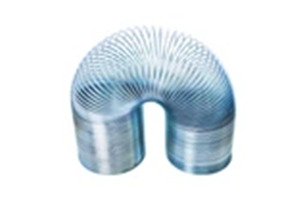
Now that was a toy that brought a high level of Return of Value to whatever our parents paid for it.
Wallpaper had a huge following in the last century. The plastered walls of older homes weren’t really finished well for paint, and wallpaper was a great way to show one’s creative style. Dry wall wasn’t extensively used until the middle of the last century.
In 1957 a new kind of wallpaper was developed, but never took off. It was called -- bubble wrap! When the product was found to have better marketing as insulation and packaging, the whole concept changed.
Actually, I rather like the idea of a bubble wrap wallpaper -- then again, that is probably just the teacher in me. Wonder if it would be less addictive than wine?
Just as the slinky could keep me entertained for long periods of time, so too could many dog toys. One in particular is the Frisbee. Though the Frisbee as we know it has only been around for about 60 years, the concept is over 100 years old.
About 1870 the Frisbee Pie Company opened and sold their pies in tin pie plates. Area college students would use the empties to give their dogs exercise -- yelling “Frisbee” as a “heads up” when it was air-born.
Not until the Wham-O toy company got hold of it in the late 50s, did the Frisbee as a plastic toy (both for dogs and people) become what we have today.
Women’s apparel has often taken cue from menswear. Generally, because menswear was less confining or cumbersome than garments women wore.
The split skirt led to the pants/slacks, dresses to suits, etc. But did you know that the high heel shoe was originally worn by men?
Back in the 900s, Persian (Iranian) men wore high heels to give them more stability when shooting their bow and arrows. The style spread to Europe where aristocratic men wore high heels to symbolize wealth and social stature.
France’s Louis XIV was known as the King of Heels - the higher and redder the heels, the more powerful the man. In fact, he passed a law (1670) that only nobility could wear high heels. By the mid-1700s, men had stopped wearing high heels. The low-heeled cowboy boots (for no sliding in the stirrups) were the last remnant of men in heels.
I hope this little history lesson has been as much fun for you as for me. Even in teaching my history classes, I wasn’t big on dates or memorizing. My students had about 4 dates to remember for the length of curriculum we had in the year, and they were primarily for place holders.
Such as: How many years between the Magna Carta and the Declaration of Independence? How many years from the Battles of Lexington/Concord to the ratification of the U.S. Constitution? Things like this weren’t for mastering the dates, but for critical thinking discussions.
These tidbits of information about common things may seem like trivia, yet they can be great conversation starters and deeper thinking.
2 notes
·
View notes
Text
Dating Disney: Tarzan

Somebody asked me to cover this movie, and considering the annoying fact that people honestly believe the Tarzan/Frozen connection theory to be true, I’m more than ready to nail down every single reason why this movie and Frozen aren’t connected.
Fashion

Tarzan’s mother is wearing her hair in a ringlet ponytail style, which exploded in popularity during the Victorian Era (1837-1901). The father is wearing a simple three piece suit as seen in the official family portrait. Tarzan’s father has the same mustache style as The Grand Duke in Cinderella, an A La Souvarov, named for Alexander Souvarov, a Russian military leader who lived from 1730-1800.

The mother’s dress resembles this one from 1890. Given that Tarzan is about 20 years old and she’s wearing this when he’s a baby, this should place the movie in 1910.

Jane Porter arrives in the Jungle wearing a yellow dress with a prominent bustle which were popular from the 1870s through the 1880s. We can see her wearing short gloves, a collar and ascot of some sort, and what she addresses as her boots, but could potentially be high heel shoes with high spats on them, which emerged in the late 19th century and fell out of fashion in the 1920s.
Technology

Around the human camp, we see many Victorian era inventions. There’s a grandfather clock (invented 1680), a phonograph with a 1907 design, typewriter with a 1911 design, a vanity mirror likely with silvered glass (1835), a blackboard (16th century), a penny farthing bicycle, popular in the 1870s and 1880s, and especially the Magic Lantern, a late 19th century educational tool.
Culture

Jane teaches Tarzan to read English with “See Jane. See Jane Run” an homage to Dick and Jane books used to teach children how to read created by William Scott Gray in the 1930s. Clayton mentions that he taught a parrot to sing “God Save the Queen”, first created in 1745. While flipping through images, we see images of the Statue of Liberty (1886) and the Eifel Tower (1889). When Tarzan agrees to go to England, the Professor and Jane exclaim that many people will want to meet him. Kings, scientists, and famous writers. The professor name drops Darwin, Kipling, and Queen Victoria. He is referring to Charles Darwin (1809-1882), Queen Victoria of England (reign 1837-1901), but the outlier and trouble maker being Rudyard Kipling (1865-1936). If the Professor expects Tarzan to meet Darwin, then Darwin must still be alive (at least when they leave England) but they’re likely not in Africa for more than a year, and even if the movie was set shortly after Darwin’s death, Rudyard Kipling is barely 20 years old himself when Charles Darwin died, and was still in school in the 1880s. His most famous work “The Jungle Book” wasn’t even written until 1894, twelve years after Darwin’s death.
Biology
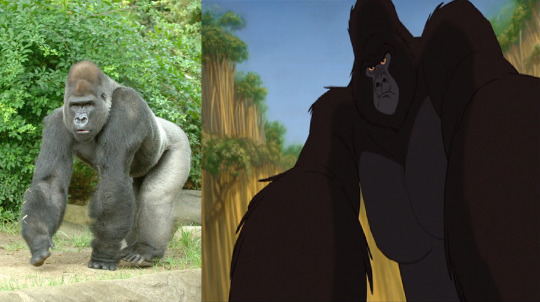
The gorilla seen in the film seem to resemble the Western Lowland Gorilla (Gorilla gorilla gorilla). Yes, that’s the real scientific name for this subspecies.
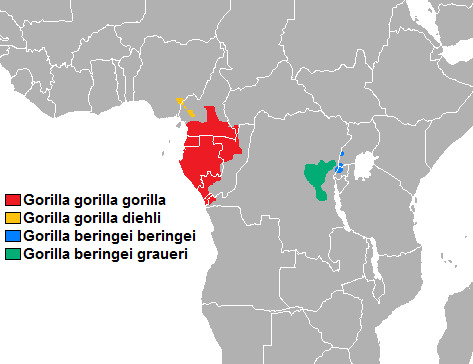
The Western Lowland Gorilla is native to Cameroon, Equatorial Guinea, Gabon, and the Republic of the Congo. They are also touch slightly into Central African Republic and Democratic Republic of the Congo, but neither of those countries are coastal, and Tarzan clearly takes place in a coastal African rain forest with Western Lowland Gorilla. Jane is chased by a troop of Mandrill Baboons whose habitat is nearly identical to the Western Lowland Gorilla. African Elephants are found in the same area, but most abundant in Gabon, and Hippopotamus used to be found all over southern Africa but now only live in scattered clumps. Nile Crocodiles can be found over most of Africa, and in every country where the Western Lowland Gorilla lives. Leopards like Sabor are also native to this region of Africa, but Mound-Building Termites are native to the south and northeastern parts of Africa, and are not in Tarzan’s neck of the rain forest. We see a Rhinoceros sharpening its horn, but Rhinos don’t live or even wander to that part of Africa. The Black-and-White Colobus monkeys we seen in “Son of Man” are not direct neighbors of Tarzan, but live close enough that him running into them isn’t too far fetched.

While searching for Gorillas, Professor Porter mentions heading west, following the Ganoderma Applanatum, a large fungus that grows on trees. However, it’s clear the Professor doesn’t always know what he’s talking about. When Jane is describing the baboon chase to her father, he cites them as being Theropithecus Baboonus, a scientific name that doesn’t exist, and the only animals with Theropithecus are all extinct.
Conclusion

Due to Professor Porter expecting Tarzan to meet Charles Darwin, the Porter party must have left England in, before, or shortly after 1882 when he passed away. Because of the equatorial rain forest climate, it’s hard to tell the passage of time. They could have been in Africa for a week, a month, or a year. Aside from characters not visibly aging there’s nothing we can really go by in terms of time frame. But unless they’ve been in the jungle for a decade, the Professor would likely know that Darwin was dead before the 1890s. This strongly indicates an 1882 to 1883 time frame. There’s definitely a lot of technological and fashion anachronisms in this movie, but the clearly defined lifespans of real people makes placing an era easier.
Setting: West Coast of Subsaharan Africa
Year: 1882-1883
Period: Victorian (1837-1901)
Language: English
Tarzan’s Birth: Approx. 1862-1864
#dating disney#disney#tarzan#jane porter#professor porter#archimedes q porter#clayton#kala#kerchak#tantor#terk#africa#victorian#19th century#gorilla#rain forest#disney jane#disney tarzan#disney renaissance
520 notes
·
View notes
Text
A lot of people are debating whether or not kpop idols should be speaking out about BLM and if black fans have a right to be angry if idols stay silent — which they do. As a white woman, I have no right or place to decide how these fans should feel or respond, but for those saying it doesn’t matter because kpop has nothing to do with BLM, let me give you a little history lesson on kpop and the genres of music it is heavily influenced by!
Korean pop music, gayo, or kpop, however you choose to refer to it as, can be traced back to 1885 when an American missionary began teaching American and British songs at schools. More western culture was introduced after the Korean War, when U.S. troops remained in South Korea. Modern kpop began to evolved in the 1990s when Korean pop musicals began to incorporate Europop and popular American music styles. It does have roots in traditional Korean music, however it is actually heavily influenced by western music and culture! Some of the biggest genres influences on kpop include rock, jazz, gospel, hip hop, R&B, reggae, electronic dance, experimental, folk, country and classical music.
For the sake of this, I’m going to predominantly be focusing on jazz, R&B, rock, and hop hip.
Jazz originated in black communities in New Orleans in the late 19th century and has origins in blues, ragtime, spirituals, classical, and West African music. The 1920s was known as the Jazz Age, and jazz is considered by many to be America’s classical music and one of America’s original art forms. It has many derivative forms, including free jazz, hard bop, modal jazz, smooth jazz, Latin and Afro-Cuban Jazz. New Orleans jazz specifically blends sounds from brass-band marches, French quadrilles, biguine, ragtime, and blues. Swing was also a very popular derivative of jazz in the 1930s with musicians like Cab Calloway, Duke Ellington, Earl Hines, Jimmie Lunceford, and Count Basie.
Minnie the Moocher (Theme Song) by Cab Calloway
In A Sentimental Mood by Duke Ellington and John Coltrane
Weather Bird by Louis Armstrong and Earl Hines
Tain’t What You Do (It’s The Way That You Do It) by Jimmie Lunceford
Splanky by Count Basie
Rhythm and blues (R&B) developed in urban Black communities in the United States during the 1940s. Some of its stylistic origins are jazz, blues, spirituals, gospel, and boogie-woogie. Since the 1980s it shifted into a new style younger generations are currently most familiar with, referred to as contemporary R&B, which blends rhythm and blues with pop, soul, funk, disco, hip hop, and electronic music. Some of the most influential R&B artists are older artists like Prince, Stevie Wonder, Michael Jackson, Aretha Franklin, Whitney Houston, Chaka Khan, Beyoncé, and Mariah Carey to newer artists like Rihanna, Ne-Yo, and The Weeknd.
When Doves Cry by Prince
Superstition by Stevie Wonder
Man in the Mirror by Michael Jackson
Respect by Aretha Franklin
I Wanna Dance With Somebody (Who Loves Me) by Whitney Houston
I’m Every Woman by Chaka Khan
Partition by Beyoncé
Hero by Mariah Carey
Needed Me by Rhianna
So Sick by Ne-Yo
Blinding Lights by The Weeknd
Rock music originated in the United States in the late 1940s, and began as “rock and roll.” Rock and roll’s biggest influences are black musical genres, two of the biggest being blues and R&B. Blues originated in the Deep South in the 1870s from African musical traditions, spirituals, and African-American work songs (this is the white guilt way of saying what they actually are Slave Songs). Blues is arguably the most influential genre in modern western music as some of its derivative forms include rock, ragtime, R&B, jazz, and country. Some of the biggest rock and roll artists include Chuck Berry, Nat King Cole, the Crows, the Penguins, and the Turbans. Even Elvis Presley, the “King of Rock and Roll” would say some of his biggest influences were B. B. King, Arthur “Big Boy” Crudup, Ivory Joe Hunter, and Fats Domino, all Black musicians.
Johnny B. Good by Chuck Berry
L-O-V-E by Nat King Cole
Gee by The Crows
Earth Angel (You Will Be Mine) by The Penguins
I’ll Always Watch Over You by The Turbans
The Thrill is Gone by B.B. King and Tracy Chapman
That’s All Right by Arthur “Big Boy” Crudup
Since I Met You Baby by Ivory Joe Hunter
Ain’t That a Shame by Fats Domino
Finally, hip hop and rap music which developed by inner-city Black communities living in the Bronx, NYC, in the 1970s. Its origins are styles of funk, disco, electronic music, dub, R&B, reggae, dancehall, jazz, spoken and performance poetry, scat singing, and talking blues. Hip hop has four key stylistic elements: MCing/rapping, DJing/scratching turntables (records), breakdancing, and graffiti writing. Due to poverty and lack of acceptance outside of ghetto neighborhoods, however, hip hop did not officially get recorded for radio or television until 1979. Hip hop has derived and has many subgenres since the 70s and now includes freestyle rap, gangsta rap, hardcore hip hop, mumble rap, trap, experimental hip hop, and more. Some major influential artists include Public Enemy, Boogie Down Productions, LL Cool J, Ice-T, Dr. Dre, Snoop Dogg, Wu-Tang Clan, Notorious B.I.G., Lil Jon, Lil Wayne, Soulja Boy, B.o.B., Drake, Nicki Minaj, Kendrick Lamar, Childish Gambino, Chance the Rapper and so so so many more.
Fight The Power by Public Enemy
South Bronx by Boogie Down Productions
Mama Said Knock You Out by LL Cool J
Colors by Ice-T
Still D.R.E. by Dr. Dre and Snoop Dogg
Drop It Like It’s Hot by Snoop Dogg and Pharrell Williams
C.R.E.A.M. by Wu-Tang Clan
Hypnotize by Notorious B.I.G.
Snap Yo Fingers by Lil Jon, Youngbloodz, Sean Paul, and E-40
Scared of the Dark by Lil Wayne, Ty Dolla $ign, XXXTENTACION
Crank That (Soulja Boy) by Soulja Boy
So Good by B.o.B.
Started From the Bottom by Drake
Feeling Myself by Nicki Minaj and Beyoncé
HUMBLE. by Kendrick Lamar
This Is America by Childish Gambino
No Problem by Chance the Rapper, Lil Wayne, and 2 Chainz
There is nothing you can say to tell me there isn’t Black influence on kpop. BTS had a whole multi-episode show where they travel to LA to train under “hip-hop tutors” Coolio, the artist behind Gangsta’s Paradise, and Warren G, a g-funk producer. Haechan calls Michael Jackson his favorite artist and inspiration. Almost all kpop groups have a rap line who “shockingly” LIKE BLACK RAPPERS AND ARTISTS. And it isn’t unheard of for kpop idols / groups to support and promote fundraising and campaigns. I’m not here to attack kpop, I’m here to explain why people can be upset by their silence.
Gangsta’s Paradise by Coolio and L.V.
Regulate by Warren G and Nate Dogg
While I am aware many of idols’ / groups’ accounts are not run personally or by their management, the silence and lack of support can hurt. I can understand why black fans want to see their idols they have been supporting support them too, especially when those idols have been, in a sense, profiting off of their culture. I can understand why black fans want their idols to support them not getting murdered in the street by police who are supposed to protect them.
For anyone saying that “this is America’s problem” and “leave it to America to figure out,” World War II happened because Hitler was committing genocide on Jewish people and it took ALL of the Allies, not just anti-nazi Germans, to take down Hitler and the Axis powers. The police and the government are committing genocide on black people. Systematic racism is a disease that the world, not just America, needs to fight.
Silence doesn’t make you an ally, silence makes you an accomplice.
Here’s how you can help:
https://blacklivesmatters.carrd.co
https://moreblminfo.carrd.co
Thread of More Places to Donate
Thread of How White Allies Can Help
A List of Black Owned Fashion / Cosmetology / Skin Care Brands
Tips on How to Engage Conversation on BLM with Conservative / Racist / Bigoted / Homophobic Family
Donate. Sign Petitions. Text and Call Local Governments. Protest. Vote. Educate. Listen.
#music history#kpop#black artists#black influence#black musicians#text post#kpop text post#jazz#r&b#hip hop#rock#rap#blues#music#black influence on music
13 notes
·
View notes
Text
James Reese Europe
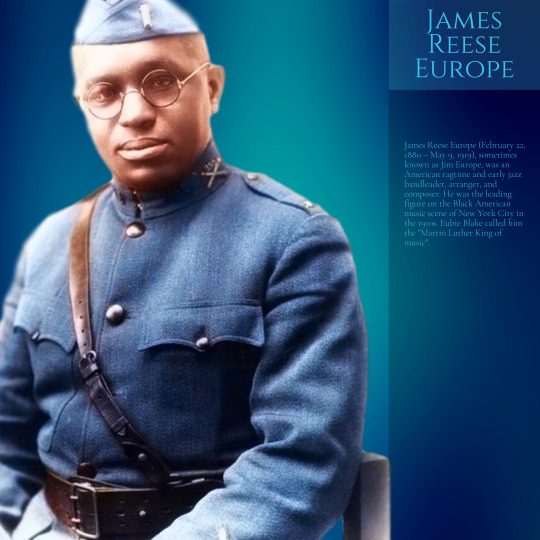
James Reese Europe (February 22, 1880 – May 9, 1919), sometimes known as Jim Europe, was an American ragtime and early jazz bandleader, arranger, and composer. He was the leading figure on the black American music scene of New York City in the 1910s. Eubie Blake called him the "Martin Luther King of music".
Early life
Europe was born in Mobile, Alabama, to Henry Jefferson Europe (1848–1899) and Loraine Saxon (maiden; 1849–1930). His family — which included four siblings, Minnie Europe (Mrs. George Mayfield; 1868–1931), Ida S. Europe (1870–1919), John Newton Europe (1875–1932), and Mary Loraine (1883–1947) — moved to Washington, D.C., when he was 10.
Europe moved to New York in 1904.
Band leader
In 1910, Europe organized the Clef Club, a society for Black Americans in the music industry. In 1912, the club made history when it played a concert at Carnegie Hall for the benefit of the Colored Music Settlement School. The Clef Club Orchestra, while not a jazz band, was the first band to play proto-jazz at Carnegie Hall. It is difficult to overstate the importance of that event in the history of jazz in the United States — it was 12 years before the Paul Whiteman and George Gershwin concert at Aeolian Hall, and 26 years before Benny Goodman's famed concert at Carnegie Hall. The Clef Club's performances played music written solely by Black composers, including Harry T. Burleigh and Samuel Coleridge-Taylor. Europe's orchestra also included Will Marion Cook, who had not been in Carnegie Hall since his own performance as solo violinist in 1896. Cook was the first black composer to launch full musical productions, fully scored with a cast and story every bit as classical as any Victor Herbert operetta. In the words of Gunther Schuller, Europe "... had stormed the bastion of the white establishment and made many members of New York's cultural elite aware of Negro music for the first time". The New York Times remarked, "These composers are beginning to form an art of their own"; yet by their third performance, a review in Musical America said Europe's Clef Club should "give its attention during the coming year to a movement or two of a Haydn Symphony".
Europe was known for his outspoken personality and unwillingness to bend to musical conventions, particularly in his insistence on playing his own style of music. He responded to criticism by saying, "We have developed a kind of symphony music that, no matter what else you think, is different and distinctive, and that lends itself to the playing of the peculiar compositions of our race ... My success had come ... from a realization of the advantages of sticking to the music of my own people." And later, "We colored people have our own music that is part of us. It's the product of our souls; it's been created by the sufferings and miseries of our race."
Some of Europe's best-known compositions include several that were co-composed with Ford Dabney (1893–1958) for the famed dancers Irene and Vernon Castle. The Castles regarded Europe's Society Orchestra among the best they had worked with and hired Europe late in 1913 as their preferred band leader with Dabney as their arranger.
Co-composed with Dabney for the Castles; Joseph W. Stern (1870–1934), publisherComposed soley by Europe for the Castles; G. Ricordi & Co., publisher
Co-composed with Dabney for Kern and Bolton's
Nobody Home
(1915)— Princess Theatre April 20, 2015, through June 1915; Maxine Elliott's Theatre June 7, 1915, through August 7, 1915
Co-composed with Dabney, lyrics by Gene Buck, for Ziegfeld's
Midnight Frolic,
sang by Nora Bayes; Francis, Day & Hunter Ltd., publisher
"Boy of Mine" (©1915)
In 1913 and 1914 he made a series of phonograph records for the Victor Talking Machine Company. These recordings are some of the best examples of the pre-jazz hot ragtime style of the U.S. Northeast of the 1910s. These are some of the most accepted quotes that are in place to protect the idea that the Original Dixieland Jass Band recorded the first jass (spelling later changed) pieces in 1917 for Victor. Unlike Europe's post-War recordings, the Victor recordings were not called nor marketed as "jazz" at the time, and were far from the first recordings of ragtime by Black American musicians.
Neither the Clef Club Orchestra nor the Society Orchestra were small "Dixieland" style bands. They were large symphonic bands to satisfy the tastes of a public that was used to performances by the likes of the John Philip Sousa band and similar organizations very popular at the time. The Clef Orchestra had 125 members and played on various occasions between 1912 and 1915 in Carnegie Hall. It is instructive to read a comment from a music review in the New York Times from March 12, 1914: "... the programme consisted largely of plantation melodies and spirituals [arranged such as to show that] these composers are beginning to develop an art of their own based on their folk material ..."
Military service
During World War I, Europe obtained a commission in the New York Army National Guard, where he fought as a lieutenant with the 369th Infantry Regiment (the "Harlem Hellfighters") when it was assigned to the French Army. He went on to direct the regimental band to great acclaim. In February and March 1918, James Reese Europe and his military band travelled over 2,000 miles in France, performing for British, French and American military audiences as well as French civilians. Europe's "Hellfighters" also made their first recordings in France for the Pathé brothers. The first concert included a French march, and the Stars and Stripes Forever as well as syncopated numbers such as "The Memphis Blues", which, according to a later description of the concert by band member Noble Sissle "... started ragtimitis in France".
Post-war career
After his return home in February 1919 he stated, "I have come from France more firmly convinced than ever that Negros should write Negro music. We have our own racial feeling and if we try to copy whites we will make bad copies ... We won France by playing music which was ours and not a pale imitation of others, and if we are to develop in America we must develop along our own lines." In 1919 Europe made more recordings for Pathé Records. These include both instrumentals and accompaniments with vocalist Noble Sissle who, with Eubie Blake, would later have great success with their 1921 production of Shuffle Along, which gives us the classic song "I'm Just Wild About Harry". Differing in style from Europe's recordings of a few years earlier, they incorporate blues, blue notes, and early jazz influences (including a rather stiff cover record of the Original Dixieland Jass Band's "Clarinet Marmalade").
Death
On the night of May 9, 1919, Europe performed for the last time. He had been feeling ill all day, but wanted to go on with the concert (which was to be the first of three in Boston's Mechanics Hall). During the intermission Europe went to have a talk with two of his drummers, Steve and Herbert Wright. After Europe criticized some of their behavior (walking off stage during others' performances), Herbert Wright became very agitated and threw his drumsticks down in a seemingly unwarranted outburst of anger. He claimed Europe did not treat him well and that he was tired of getting blamed for others' mistakes. He lunged for Europe with a penknife and was able to stab him in the neck. Europe told his band to finish the set and he would see them the next morning. To Europe and his band the wound seemed superficial. As he was carried away, he told them "I'll get along alright." At the hospital, they could not stop the bleeding and he died hours later.
News of Europe's death spread fast. Composer and band leader W. C. Handy wrote: "The man who had just come through the baptism of war's fire and steel without a mark had been stabbed by one of his own musicians ... The sun was in the sky. The new day promised peace. But all the suns had gone down for Jim Europe, and Harlem didn't seem the same." Europe was granted the first ever public funeral for a black American in the city of New York. Tanney Johnson said of his death: "Before Jim Europe came to New York, the colored man knew nothing but Negro dances and porter's work. All that has been changed. Jim Europe was the living open sesame to the colored porters of this city. He took them from their porters' places and raised them to positions of importance as real musicians. I think the suffering public ought to know that in Jim Europe, the race has lost a leader, a benefactor, and a true friend."
At the time of his death, he was the best-known black-American bandleader in the United States. He is buried in Arlington National Cemetery.
4 notes
·
View notes
Text

Foster Studios
404 East Grace Street
Built, 1927
Architect, Henry Barnham
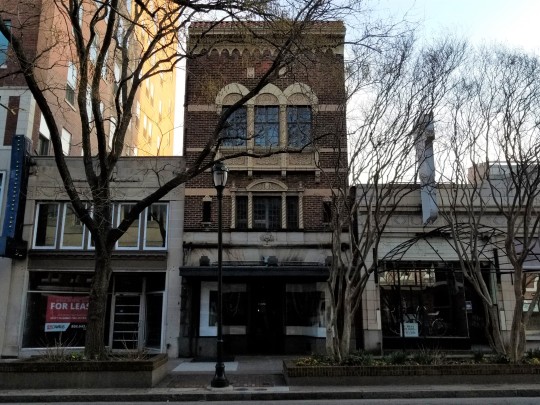
February 2019
A building for those who love fantasy.
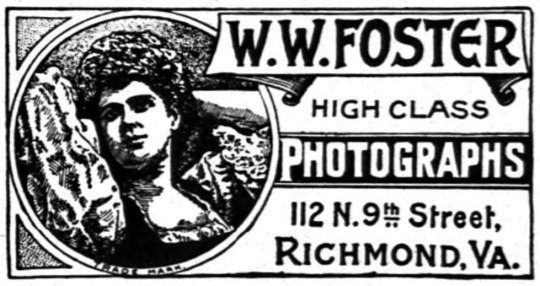
(Wikimedia) — from the 1911 Richmond Directory, showing the location before the Foster Studio building was constructed
This spectacular, small building is Spanish fantasy designed by Richmond architect Henry Barnham for W. W. Foster, owner of the city's most popular photographic studio.
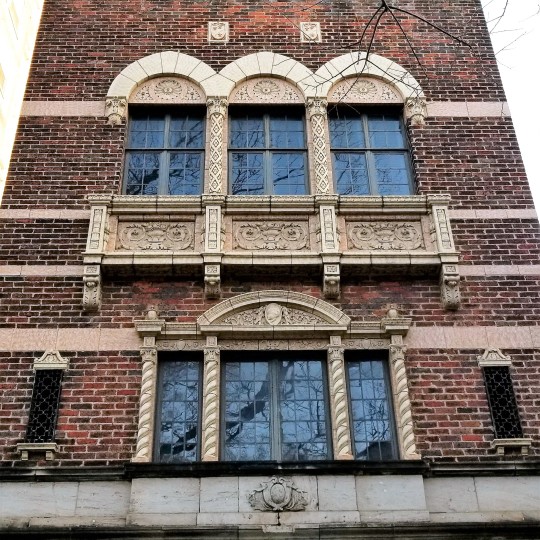
February 2019
The building is one of the city's more elaborate examples of the Spanish/Moorish style, ranking with theaters like the Towne or the Mosque, all of which were built about the same time.
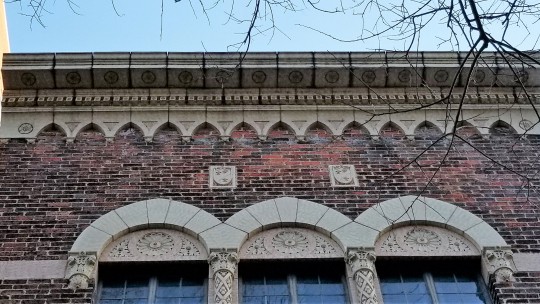
February 2019
The dark, heavily textured brown brick effectively contrasts with the terra cotta ornament in buff and white. The original show windows and canopies are preserved, marred only by the new sign. The interior carried out the architectural theme, with the entrance hall treated as a diminutive streetscape, and an upper level window overlooking the space.

[ADR] — showing the uncomplimentary modern sign above the canopy
This building is well preserved; the modern sign makes no effort to compliment the front.
Barnham proposed developing a gas station at the corner of Belvidere and Broad streets with resembled a Mexican village, suggesting that he may have specialized in the Spanish style in its more fantastic expressions. [ADR]

(FindAGrave) — Walter Washington Foster
Richmonders may be more familiar with the classic photographs of the Dementi Studio, but Walter Foster operated his own studio here in Richmond from the late 1870s to the mid-1930s. The Virginia Museum of History & Culture (AKA Virginia Historical Society) has a fascinating collection of his glass plate negatives, available online. (Virginia Museum of History & Culture)
(Foster Studios is part of the Atlas RVA! Project)
Sources
[ADR] Architecture in Downtown Richmond. Robert P. Winthrop. 1980.
3 notes
·
View notes
Text
Vintage Recipe Boxes and Cards
November ushers in a happy season of holiday cooking, inspiring me to focus this month’s featured post on vintage recipe file boxes and cards.
File boxes and index cards are not obsolete, but before the computer age, they played a much larger role in collecting and storing information. Index cards were invented in the 1640s by Carl Linnaeus, the father of modern taxonomy. Originally pieces of regular paper but later made from more durable card stock, index cards proved very useful to many, and became the backbone of the library cataloging system that began in the 19th century. In 1870 Melville Dewey standardized library indexing, and the Dewey Decimal System was used until the 1980s, when information compiled by hand began to give way to indexing software.
Histories of the index card center on its use in gathering and organizing scientific information and library catalogs, with very little, if anything, said about recipe collection and organization, so I’ll simply share what I know.
In the 20th century many homemakers used index cards to store and share favorite recipes. Standard index cards were joined by cards specifically printed for recipes, often bearing the words “From the kitchen of ______, ” with space for the cook to write in her name. Companies in the food industry and agricultural associations often distributed cards with printed recipes utilizing their ingredients, and some homemaking magazines had cut-out sections with recipes cards. These cards were generally saved in file boxes.
Vintage recipe file boxes were usually made from wood or metal, although I’ve occasionally seen plastic examples. The standard index card size was 3x5 inches, but some were 4x6 or 5x7. Larger cards, including ones that folded down to the standard 3x5 size, were popular for longer or more complex recipes.
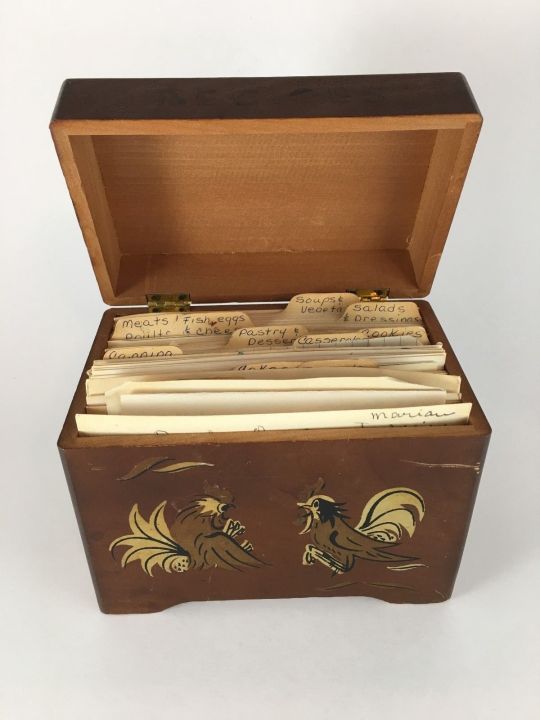
Vintage wooden recipe box with rooster design, from an estate sale. Hand-written category tabs organize this recipe collection. This is a very typical file card recipe collection.
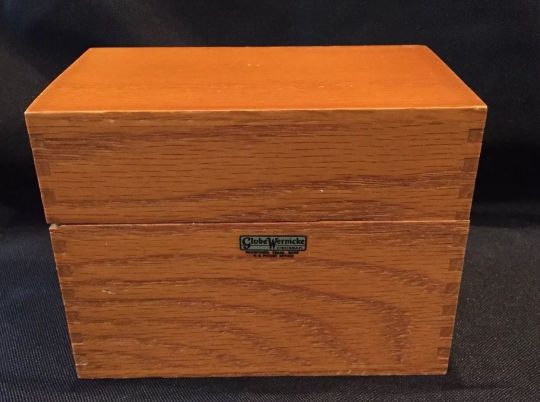
Vintage dovetail oak index file box by GLOBE-WERNICKE.
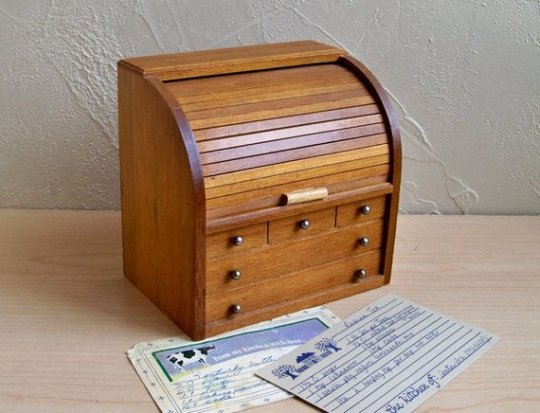
Vintage recipe file box made to look like a miniature rolltop desk. This was a popular style.
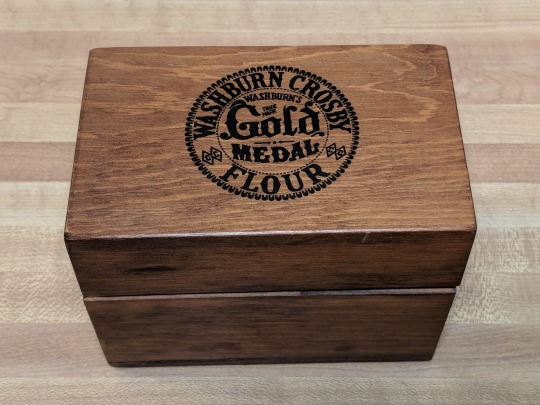
I’ve had this wooden recipe file for decades. It was a promotional item from Gold Medal Flour.

Vintage Ransburg hand-painted recipe file box.
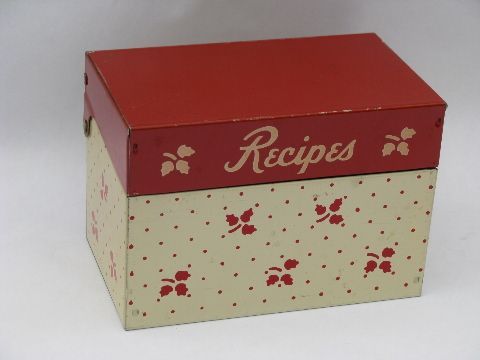
Vintage red and ivory metal litho “Recipes” file box.
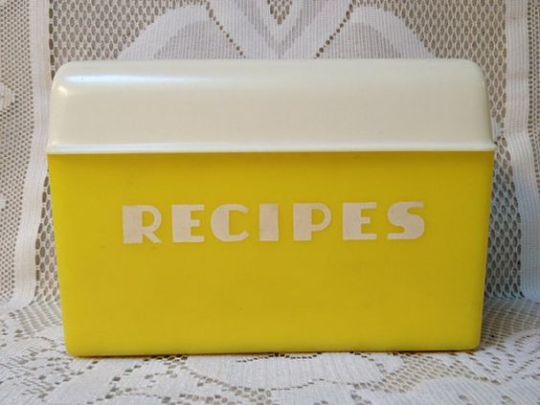
Vintage yellow and white plastic “Recipes” box.
Ransburg produced hand-painted metal recipe boxes. Most other metal recipe files were decorated with lithography, many by the Ohio Art Company. Founded in 1908 and based in Bryan, Ohio, Ohio Art is still in business, famous for its metal lithography and manufacturing, and also for its toys. Ohio Art made wonderful metal toy dishes and toy pail and shovel sets that delighted generations of children. They later turned to other types of toys, including the Etch A Sketch.
Another name that comes up often when finding vintage metal litho recipe file boxes is J Chein & Company. Founded in New York, J Chein primarily manufactured toys from 1903 through the 1980s. J Chein’s stamped tin litho toys from the 1930s through the 1950s, depicting the circus and amusement park attractions, are especially well-known.
I have also seen examples of metal litho recipes boxes by Syndicate Manufacturing of Phoenixville, Pennsylvania, and by Stylecraft.

Isn’t this wonderful? Vintage Stylecraft metal litho red file box. “RECIPES” is spelled out with spice jars.
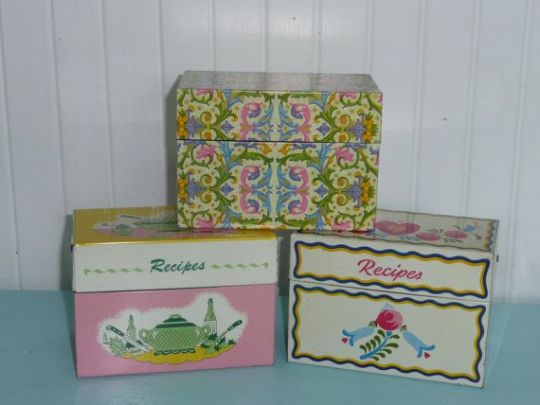
A collection of Mid-Century metal litho file boxes, including one with a pretty Florentine scroll design, and two marked “Recipes.”
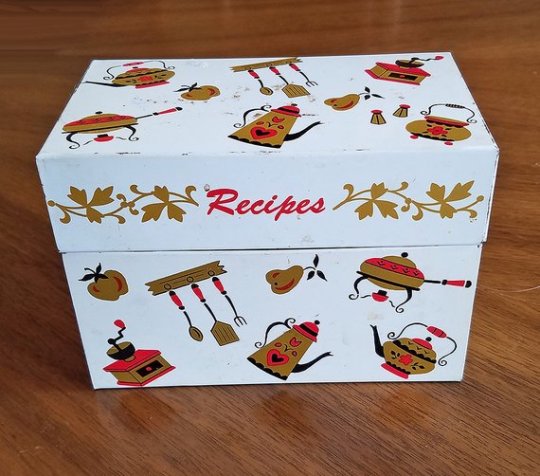
Mid-Century Ohio Art metal litho “Recipes” file box, decorated with fruit and kitchen items. In addition to the usual coffee and tea pots and coffee grinders, there are even chafing dishes.

Vintage Syndicate Manufacturing metal recipe box with a Pennsylvania Dutch folk art-inspired design. This model was often seen in the 1960s and 1970s.
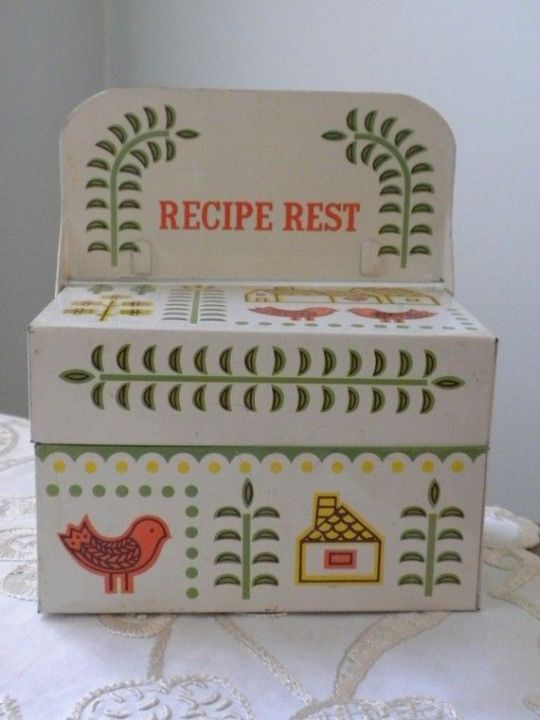
This vintage metal file box includes a “Recipe Rest” for propping a file card while cooking.
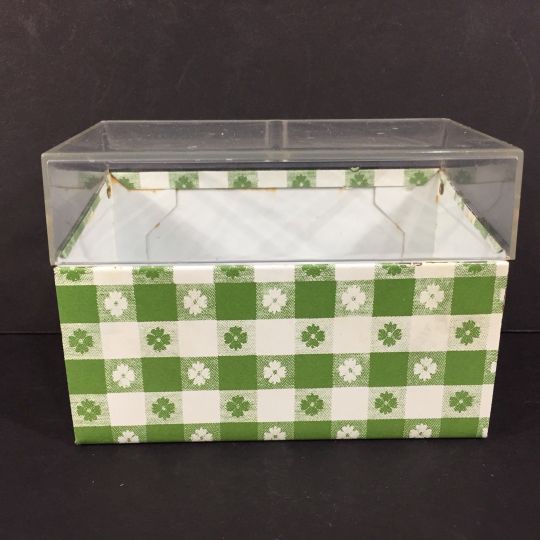
Vintage J Chein Co recipe file with a green and white tablecloth plaid metal litho bottom and a clear lucite top. In business from 1903 through the 1980s, J Chein & Company was an American toy company, best known for its tin litho toys produced from the 1930s through the 1950s. Some examples of J Chein recipe boxes are marked “J Chen,” which makes me suspect they were made overseas.
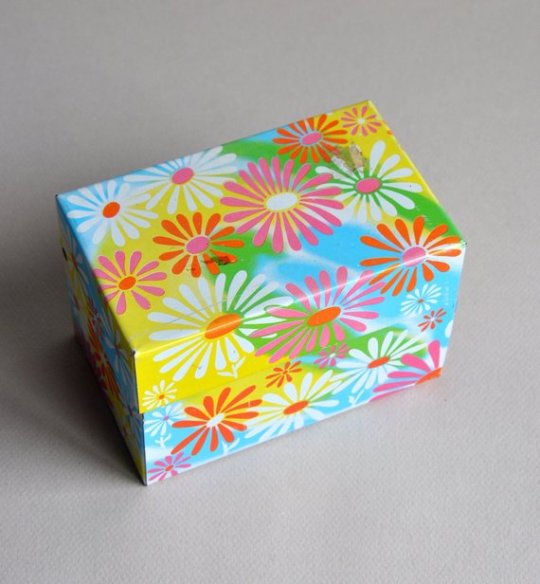
Vintage “flower power” design metal recipe file, marked Syndicate Mfg Co, Phoenixville Penn. The illustration dates this one to the late 1960s or early 1970s.
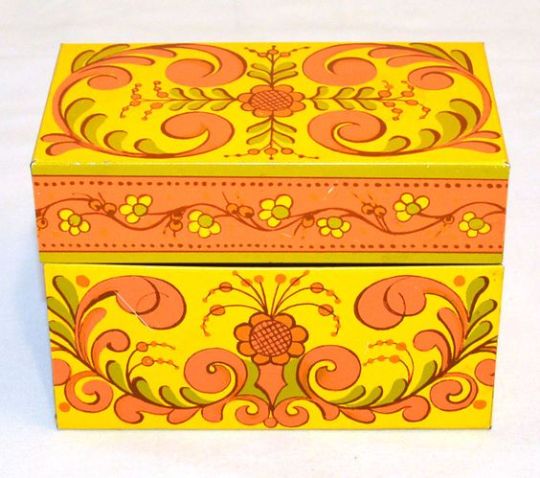
Vintage metal recipe file box, sold by Avon.
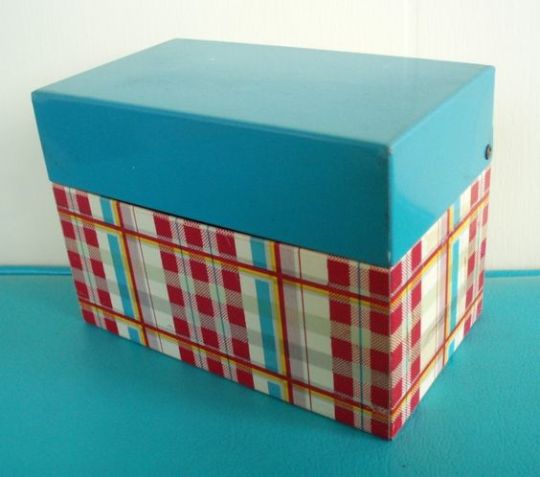
Vintage Ohio Art metal litho recipe box with a plaid base and a solid blue top.
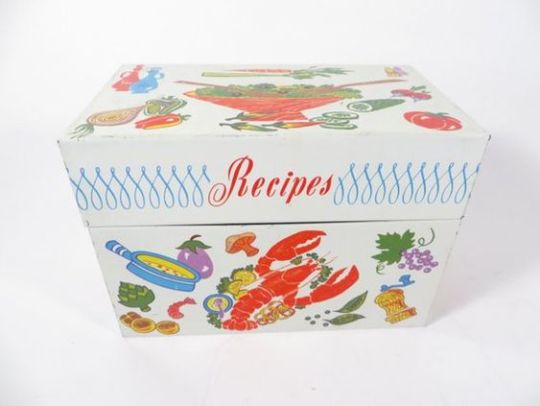
Vintage metal Ohio Art recipe file, from my personal collection. The Ohio Art Company is famous for its metal litho products, especially kitchen ware and toys.
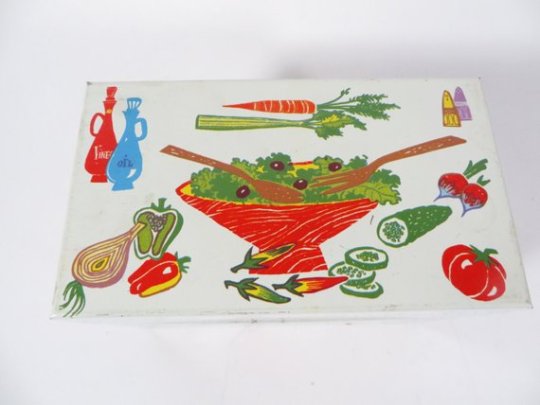
Illustration on the top of my vintage Ohio Art recipe box, showing a salad and its ingredients.

Interior of the vintage Ohio Art recipe file box.
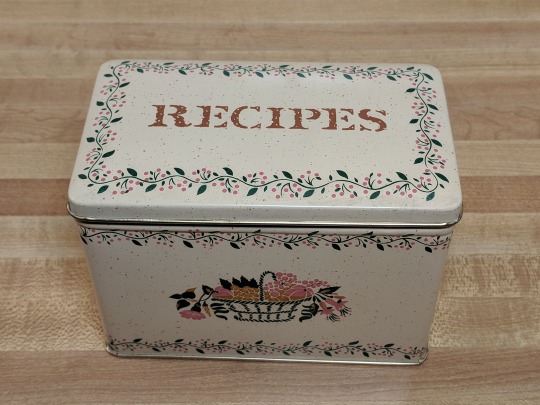
My other recipe file is this “Americana Stencil Metalware Recipe Box” bought at the local Kmart in the 1980s. The box it came in is marked copyright 1984 The Tin Box Company of America.

I started my recipe collection when I was growing up, and hand-decorated plain index cards with little drawings.

As a young adult I began using printed recipe cards, and also exchanged recipes with friends. Plastic sleeves protect the cards.

Printed recipes from the food industry, given out at grocery stores and county fairs.
Today many cooks keep recipes electronically, yet wood or metal recipe boxes, and the cards and dividers for them, are still sold. I enjoy finding recipes online, but still find it useful and satisfying to keep my favorites on index cards. This low-tech tradition takes up very little space, makes it easy to reference a recipe while cooking, and offers a method of preserving recipes that is not dependent on software or hardware.
It’s easy to start or add to your own collection. You can find many types of new or vintage cards and boxes. I find protective plastic sleeves helpful for keeping my cards clean.
Promotional or branded recipes boxes from companies such as General Mills and Campbell’s Soup have been offered to generations of cooks. I’ve shared a photo of a wooden General Mills box I’ve been using since the 1980s or early 1990s, and they’ve also had metal recipe boxes. Campbell’s Soup has a metal litho file box “starter set” of cards with Campbell’s Soup recipes plus 24 blank cards, and Coca-Cola has a set of 75 recipe cards with color photos sold in a metal litho box. (I have an older version.) There is also a Jell-O Recipe Collection with a metal box containing 76 cards with Jell-O, Cool Whip, Baker’s, and Jet-Puffed recipes. At the time of this posting all of these sets are available on Amazon, and I’m sure you can find even more.
I wish you the fun and joy of holiday cooking, and hope you’ll have a chance to share or swap a recipe or two along the way!
#vintage kitchen#recipe box#recipe collections#recipe files#index cards#Carl Linnaeus#taxonomy#melville dewey#dewey decimal#globe-wernicke#gold medal flour#ransburg#ohio art#ohio art company#j chein & company#metal litho#tin litho#stamped litho#Syndicate Manufacturing#stylecraft#midcentury#avon#the tin box company of america#campbell's soup#CocaCola#jell-o
2 notes
·
View notes
Text
Abridged history of early 20th century Chinese womenswear (part 1: 1890s & 1900s) *improved version

Source here
*I’m fixing and reposting the first two posts of this series because back then I had no idea how Tumblr formatting functioned and they deserve better. I’m keeping the shoddy original versions for archival purposes.
*After some thought I think it makes more sense to group the 1890s and 1900s together.
Other posts in the series:
Part 1: 1890s (original)
Part 2: 1900s & 1910s (original)
Part 3.1: 1920s-silhouette
Part 3.2: 1920s-design details
Part 3.3: 1920s-accessories, hair & makeup
Part 4.1: 1930s-silhouette & design
Part 4.2: 1930s-hair, makeup & accessories
Part 5: 1940s
Part 6.1: 1950s-Hong Kong, Macau, Taiwan & friends
Part 6.2: 1950s-mainland China
Intro & context
In order to understand early 20th century Chinese fashion we have to go back a bit into the past to have some clue about the context. When the Manchus conquered China and established the Qing Dynasty in the mid 17th century, Han Chinese men adopted Manchu style clothing but Han Chinese womenswear remained independent and separate from Manchu womenswear. Han Chinese women retained the habit of wearing a two piece ensemble as the outermost layer, unlike Manchu women, who wore a single floor length robe. I will be only discussing Han Chinese women’s fashion in this series.
In the 19th century, Han Chinese women wore 袄裙 aoqun, a two piece ensemble consisting of a robe and a skirt. The robe had a very low 立领, standing collar. In the second half of the 19th century, the robe in aoqun had a very generous and roomy cut and huge sleeves, a look which reached its peak in the 1860s and 70s. The hem of the robe hit the knees, the length in vogue since the 1870s. The collar of the robe is very low, only providing enough space for one button, likewise in fashion since the 1870s. The robe is closed with 盘扣 pankou, which in this era were always plain with either a bead or fabric knot tip. The robe closes at the side, usually at the right side at the 大襟 dajin, the side closure, however examples of robes with closures on the left also existed. Robes with closures on both the right and left were also a thing, a style called 双襟 shuangjin, double closure. Shuangjin robes were derived from a men’s riding vest, the 巴图鲁坎肩 batulu vest (batulu is Manchu for “warrior”), that could be opened from both sides, and would experience a revival in the 1920s.
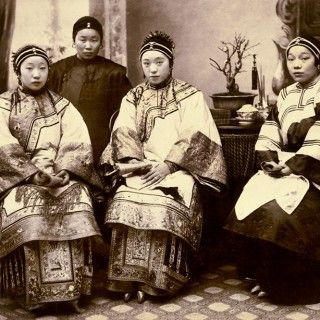
Source here
1870s/80s photograph of a group of women in aoqun, the two skirts on the left are the elaborate mamian style, the one on the right is plain.
In aoqun, the skirt was usually of a style called 马面 mamian, made of two long horizontal pieces of pleated fabric with two flat sections each sewn to a waistband with one flat section overlapping, creating a wrap skirt that once worn around the wearer’s waist, appears to have two unpleated sections, one at the front and one at the back. This skirt was very decorative in the 19th century, full of embroidery, tassels and elaborate trim, sometimes giving the illusion of a separate apron being attached (I’ve seen this weird stereotype that traditional Chinese womenswear has a separate apron at the front this is complete bogus). The robes were likewise heavily decorated around the seams, ceremonial outfits like wedding gowns could be so full of embroidery that the original fabric is hardly to be seen.
The combination of robe and pants, 袄裤 aoku, was also a common way of dressing since approximately the 1800s or 1810s. This combination would become the norm in the 1890s.

Source here
1870s/80s photograph of a woman in a ginormous ao, roomy pants and with bound feet.
Another noteworthy fad was bound feet. The middle of the 19th century was the pinnacle of foot binding and fashionable women had incredibly small feet, dubbed “lotus feet”. This was achieved by wrapping tight foot binding cloth around the feet since childhood and restricting the growth of the feet, I think also breaking a couple bones in the process. Women wore foot binding cloth and baggy stockings underneath their shoes, tied up with garters below the knees. Foot binding is said to severely restrict mobility and cause intense pain; I don’t doubt the pain part but I’m not sure about mobility since I’ve seen plenty of photographs of women with bound feet roaming about the streets.
Not every woman did foot binding though, it depended heavily on region, class and the individual family. For one, Manchu women all had natural feet. For Han women, an account from the 1850s said that in Beijing, every five or six out of ten women did not have bound feet, and that probability is three or four out of ten in the countryside. In the provinces along the southern coast, most women did not bind their feet (this probably has to do with the influence of indigenous cultures in the south, since foot binding was primarily a Han fashion), whereas in the northwest almost every woman had bound feet. By the way, I really don’t like how articles on foot binding describe it in the most sensational way possible, why is it so hard to approach history with peace of mind? And it pisses me off that all the articles containing 1890s photographs only talk about the foot binding as if there is nothing more of value in portraits of whole ass women.
Anyway, if you are interested in learning more about foot binding, check out Cinderella‘s Sisters: A Revisionist History of Footbinding by Dorothy Ko, recommended by @thefeastandthefast . Or just anything written by Dorothy Ko tbh.
Silhouette
In the 1890s, the cut of the aoqun began to become more slender and form fitting, commonly believed to be a result of westernization. But I think it’s also because the wide sleeve look has also been in fashion for quite a while now (some 80 years or so) and people were getting tired of it. The robe inherited the knee length hem from the 1880s but was less baggy and took on a more straight cut silhouette. The collar remained quite low until the end of the decade. Pants were overwhelmingly more popular than skirts in the 1890s, I speculate this may be due to a rising interest in feminism and women wanting more mobility, but aoku was also very popular in the 1870s and 80s in general so it may have also just carried over. The pants were still ankle length and straight cut but less roomy than earlier 19th century models. Overall the 1890s just looks like a shrunken and simplified version of the 1880s.

Source here
The aoku as of the 1890s.
By the second half of the 1900s, the collar began to rise, becoming medium height. This was kind of reminiscent of late 18th century Han women’s collars I mentioned in this post on Chinese standing collars. The robe and pants shrunk further, becoming quite tight fitting. The robe was still around knee length. The pants were especially tight and could be considered skinny. Foot binding became less common and many women had natural sized feet. However, since foot binding is something that begins in the childhood, the fact that many women without bound feet appeared in the 1900s meant that many parents started to reject food binding in the 1880s and 90s.

Source here
Ca. 1907 photograph of a group of women, possibly students, in tight fitting aoku.
Design details
The 1890s saw the mass disappearing of wide, embroidered trims around the seams, popular throughout the 19th century. The use of multiple rows of binding/trim from the 1870s and 80s was continued, albeit in a much more minimalistic and geometric way. I’ve seen a lot of plain white ao finished with multiple rows of black binding of different widths, it’s mighty avant-garde and elegant. Because clothes of the era were still constructed in the older Chinese method, they had a seam down the middle of the sleeves used to extend the length of the sleeves; this seam could be bound and decorated but it was not compulsory. Actual embroidery on the robe and skirt/pants was rare, if not non-existent; completely plain fabric was the norm. The ao of this era commonly had a 厂字襟 (厂 shaped closure), where the front placket is held up by one or two buttons and then closed by more buttons down the side seam. This style of closure was first popularized for Han women’s clothing in the 1800s and 1810s, before that Han women’s clothing closures were a straight line from the collar to the armpit. The pankou used to close the ao of this period became a lot more elaborate and the main source of decoration; I have a whole ass post on them here. A general air of simplicity, comfort and proportionality dominated the fashion of this era. In the mid 18th century, Han women’s robes started having folded cuffs (possibly borrowed from Manchu court dress), called 挽袖 wanxiu, and these became fake and represented by a piece of trimming in the 1850s. By the 1890s this design feature largely disappeared, leaving the sleeve edges either plain or simply bound.

Source here
Three women in aoku, late 1890s. I looooove the look on the far left, I will probably make it some day.
Going into the 1900s, the geometric trims became more simplified and austere, while the pankou became increasingly ornamental.
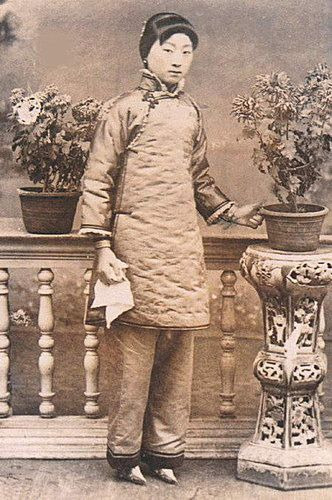
Source here
Late 1900s photograph. The robe is trimmed with fur and thin, geometric binding, and closed by very ornamental pankou.
Hair & Makeup
There were no significant changes in hairstyling in the 1890s, fashionable women would wear existing 1880s hairstyles but style them with bangs. A common style I’ve seen in photographs was long hair pulled back into either one big bun at the back or two smaller ones at the sides. The short bangs were usually very neat, precisely cut and sat closely to the forehead. Elastics did not exist, so Chinese women used strings and hairpins to tie their hair together. Hairpins of this era were usually very thick and sturdy, a single one was enough to hold all your hair into a bun. It was popular to use flowers and/or pearls to form a ring of decorations around a bun.
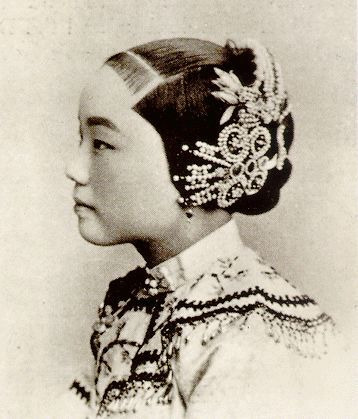
Source here
Common 1890s hairstyle, for most people the decorations weren’t so elaborate.
A popular headpiece was this thin headband adorned with pearls worn at the place where bangs should be, although that has been around since the 1870s as well.

Source here
Ca. late 1890s. Some women wearing the pearl headband.
Around 1905 the bangs began to grow in length but still weren’t long enough to cover the eyebrows. They were longer at the sides and shorter in the middle, creating this volume and curve at the forehead.
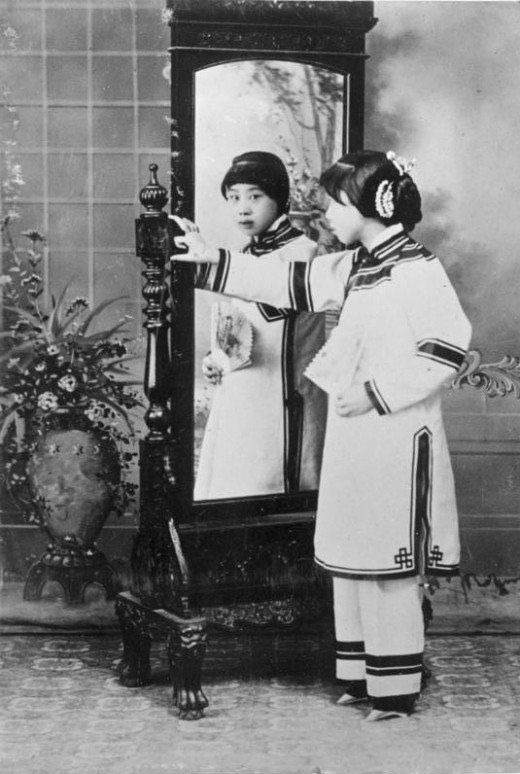
Source here
Photograph ca. 1905. Long bangs.
By the end of the decade these evolved into a being with a will of its own. Long hair tied into braids or low buns became fashionable instead of tight, high buns.

Source here
Calendar painting from 1911.
Fashionable women in the 1890s wore little to no makeup, because of the influence of female university students who were usually without makeup. In the 1870s and 80s, thick makeup was more common and was a trend popularized by sex workers in Shanghai, thus becoming increasingly considered indecent in the 1890s. I find this quite problematic cause respectability politics suck and there’s nothing wrong with wearing fashion trends invented by sex workers. All the straight male writers of the 1890s and 1900s praising female students for being “pure” and ”hygienic” in contrast to the supposedly nasty sex workers make me cringe to my core, it’s just pitting women against each other and setting us up for “I’m not like other girls” in my opinion.
The common makeup look includes white power, lipstick and blush. The lipstick shape was usually a tad smaller to the actual lips and blush was applied in large areas toward the outside of the face.
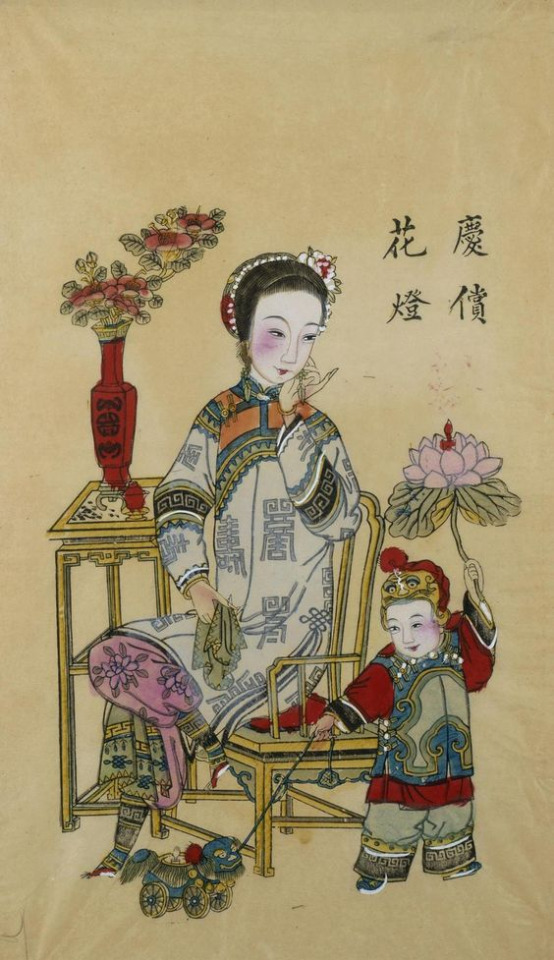
Source here
Standard 1890s and 1900s hair and makeup look. This drawing is probably from around 1902, it’s a bit more festive folk art than fashion plate so take the patterns with a dash of salt.
Undergarments
Unfortunately I don’t have many pictures for undergarments of the era but I can describe them to you. Since women commonly wore pants, they would usually wear another layer of pants (could be considered drawers) underneath that was of a similar construction but plain and easy to launder. Panties and such didn’t exist so drawers were the innermost layer, enough to protect women’s private parts. Likewise for the robe, another plainer, sturdier version would be worn underneath. In the mid 1900s, as the sleeves of the outer robe began to shorten, the undershirt became more form fitting at the wrists and could serve a decorative function.
Chinese women in the 19th century bound their breasts with long strips of fabric to achieve the flat look. I’m not exactly sure how this is done but basically you wrap fabric tightly around your chest until the boobies are concealed. A famous undergarment of the Qing Dynasty was the 肚兜 dudou, which was actually unisex. The female only version was called 抹胸 moxiong, 袜肚 wadu or 袜腹 wafu, the latter two are etymologically similar to earlier words for “corset” or “a pair of bodies”. However, unlike what many later 20th century artists would like you to believe, wearing only dudou on the upper body was not legit underwear for grown up women, as it was usually worn in conjunction with breast binders as an extra layer of warmth. It was also worn very tightly around the breasts and waist, not tied loosely like in paintings or period dramas nowadays.
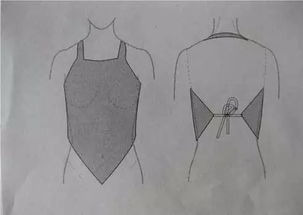
Source here
Dudou diagram.
Shoes
Women began campaigning against bound feet in this period and many drawings depicted women with natural feet. However, if a woman had her feet bound since childhood it’s difficult for them to return to their natural size, so some women who were born in previous decades would still have very small feet, even if they began to reject it at this time. Women’s shoes of Western construction weren’t yet so common so most women wore Chinese style shoes, which were commonly made of fabric and had a slightly upward pointing toe. Women with bound feet would use a long piece of ribbon/cloth to wrap their feet (to maintain the shape) and wear small fabric pumps with a white sole. These could be flat or have a teeny tiny bit of wedge heel, called 弓鞋 gong xie, bow shoes. Women without bound feet would wear normal sized pumps, likewise of fabric, with slightly upward pointing toes and a thick white sole. Embroidery on shoes was a huge thing in the 19th century and before but by the 1890s it started to disappear as well, and shoes in the 1890s were commonly plain. In the 1900s, Western leather shoes were increasingly popularized, but it wasn’t until the early 1910s that this popularity reached its height.
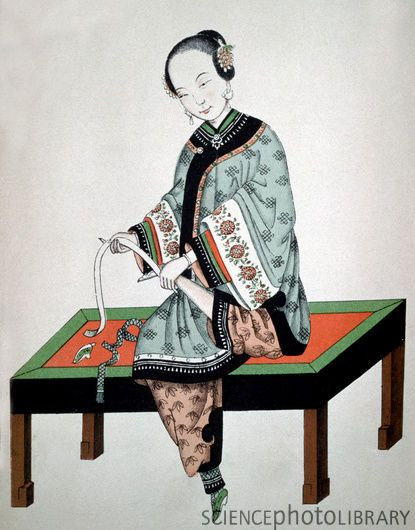
Source here
Foot binding cloth.

Source here
Shoes for bound feet.

Source here
Woman with natural feet wearing Chinese style pumps. Western style knit stockings were becoming popularized in the 1880s for women with natural feet as well.
Some editing afterthoughts
I’ve been looking more into 18th and 19th century Chinese fashion lately and I realized I held some deep rooted misconceptions about the Qing Dynasty. For some reason I always considered the 1870s and 80s look with the elaborate, big robes conservative or backwards, which is really not fair. Chinese women’s fashion was revolutionized in the beginning of the 19th century, going from the flowy, slender robes of the 18th century to stiffer, more structured robes with flared sleeves. Styles also differed dramatically from decade to decade, it’s just not very well studied and there’s a stigma around Qing Dynasty fashion so people don’t get into it as much. Because Han women were allowed to continue wearing Han style clothing into the Qing Dynasty, a lot of 18th century reproduction ensembles nowadays get mistakenly labelled as Ming style hanfu, which really isn’t helping... I was definitely not alone in this though, the perception of Qing Dynasty Han women’s fashion most people nowadays have is: in the first couple years Han women were allowed to wear Ming style hanfu, but then bam the late 19th century look was forced upon everyone. This view is super not nuanced and false on almost every level, but it is extremely widespread and I don’t blame you at all if you also think like this, this was me just two months ago too... A wise woman (I mean Karolina Zebrowska) once said that everything in fashion history happens gradually, which is also extremely true for Chinese fashion history.
I’ve really started to question what modernity in fashion means because the elaborate 19th century Chinese look that white people back then considered the epitome of conservative Chinese clothing was actually new and exciting in the beginning of the 19th century. I can’t help but wonder if this view that Chinese clothing as of the 1870s and 80s was symbolic of Chinese culture’s “backwardness” and “stagnation” was a product of colonization and white imperialists’ efforts to demonize Chinese society and take things out of context. I would prefer to say that Chinese fashion westernized a lot during the 1890s and 1900s but not necessarily modernized because what is modernity. Fashions change and that is the most normal thing on the planet.
If you read what white historians or politicians wrote in the late 19th/early 20th century about Chinese fashion or culture (which I highly recommend you don’t, that shit is detrimental to your mental health), it becomes obvious that the majority of them have no clue what Chinese fashion looked like before the 19th century and how we got to what we had in the 19th century in the first place, so they just assumed that Chinese fashion always looked like that and that we haven’t progressed as a culture in hundreds of years lmao. Bullshit pseudo-Darwinism at its finest. Oh or if you look up 18th century European Orientalist paintings depicting imaginary Chinese characters, the clothes they wore and the hairstyles they had were so far off from what actual 18th century Chinese fashion looked like to the point they felt racist and were uncomfortable to look at. I stumbled across so many of them when looking for 18th century Chinese painting and every time I see one it almost gives me a stroke. So I think it’s really important to acknowledge that Han Chinese fashion of the 18th century is a valid field of study.
In my original 1890s post I said that the elaborate embroidery and trimmings started to appear on Han women’s fashion around this time because of Manchu influence, I take that back because I’ve realized it’s a whack claim. I’ll explain it more when I make some posts on the 19th century later.
Reworked part 2 is coming soon as well :)))
#1890s#1900s#19th century#historic fashion#qing dynasty#vintage fashion#vintage hair#vintage shoes#chinese fashion#chinese history#abridged history of early 20th century chinese womenswear#清汉女装#edwardian fashion
397 notes
·
View notes
Text
11 Essential and Popular Whiskey Cocktails for 2021
Whiskey holds a world of flavor in just a drop of amber liquid. It comes in many styles, be it rye, bourbon, or Scotch — and a range of tastes, from oaky or smoky, to spicy or sweet. While it may have a reputation for being a heavier, stronger spirit, there’s an array of whiskey-based cocktails that will satisfy any palate, whether you prefer something light and tangy, or something dark and peaty.
There’s a reason everyone loves whiskey, from Japan to Ireland. Firewater’s universal. And no matter the place or time, there’s a whiskey cocktail that’s perfect for the occasion — you can cool your summers with a Bourbon Peach Punch, or weather your winters with a fireside Hot Toddy. Here are 11 of the best and most essential whiskey cocktails that are both timeless and seasonless.
Sazerac
The first Sazerac was made in New Orleans in the early 19th century by Haitian pharmacist Antonine Amédée Peychaud. The original drink was intended to be a medicinal concoction, and was made using brandy. More modern versions use rye as a base, but we’re still convinced it has healing properties — if you’re in desperate need of a rich libation and a light buzz, that is. Just add some rye, Demerara syrup, Peychaud’s bitters, and your desired amount of absinthe into a mixing glass and stir. Garnish with a lemon rind and toast to NOLA.
See Recipe
Whiskey Sour
The Whiskey Sour is a stellar example of “less is more.” The American classic needs only a few basic ingredients in order to hit the spot: whiskey (typically bourbon), simple syrup, and any kind of citrus juice. Adding some egg whites to the mix can give it a silkier texture, but it isn’t required for taste — sours are easy to knock back, regardless.
See Recipe
Hot Toddy
Drinks aren’t always served best cold. Case in point: the Hot Toddy. You can make one using ingredients you probably already have on hand — honey and lemon. The best part of it all? We’ve gathered some evidence that a good Hot Toddy may help drinkers battle a cold or flu, so you can sip in peace, knowing it’s for your health. This is a home remedy we can get behind.
See Recipe
Manhattan
Want to look sophisticated? Go to your local drinkery and order a Manhattan. Legend has it the classic cocktail has been around since the 1870s, and originated in New York City, mixed together in honor of the hometown presidential candidate Samuel J. Tilden. One can be made with bourbon or rye, though some more modern versions opt for bourbon. Just mix together the whiskey of your choice, sweet vermouth, some bitters, and garnish with a Maraschino cherry or an orange peel. (Or make it a Perfect Manhattan by splitting the sweet vermouth with dry vermouth.)
See Recipe
Old Fashioned
The Old Fashioned is — well, it’s in the name. It’s one of the oldest cocktails in history, and there’s no doubt that its quality has led to its longevity. All it takes to make is a healthy helping of bourbon or rye, a bit of simple syrup (or a sugar cube), and some Angostura bitters. You can top it with an orange or lemon peel and sip on it thoughtfully like “Mad Men’s” Don Draper.
See Recipe
Bourbon Peach Punch
While bourbon’s commonly used in a number of fruity tea punches given its Southern roots, we figured the peach is one of its better pairings. It’s definitely one that speaks to its origins. This recipe uses frozen peach slices in place of ice cubes, so there’s no need to worry about a diluted drink if you’re imbibing during the afternoon of a summer scorcher. It also calls for pineapple and lemon juice, and a dash of black pepper to enhance the natural spiciness of the bourbon while complementing the sweetness of the fruit.
See Recipe
Blood and Sand
Raise your glasses, movie buffs. The Blood and Sand was invented in 1930, following the 1922 silver screen debut of Rudolph Valentino’s bullfighter movie “Blood and Sand.” It’s one of the few classic cocktails made with Scotch. You’ll also need some cherry Heering, sweet vermouth, and orange juice before you can start sipping.
See Recipe
Boulevardier
The Boulevardier has its roots in the Prohibition era, and it’s easy to see why — the bourbon-based riff of the Negroni (which is made with gin) is so delicious we’d go in the slammer for it. Served with some Campari and sweet vermouth on the rocks, it has a refined European feel with an American twist. In fact, the drink was invented by an Erskine Gwynne, an American living in Paris in the 1920s.
See Recipe
Mint Julep
The Mint Julep was invented in the late 1700s and was originally intended to be a digestive aid. While we can’t exactly speak to its medicinal merit, we can vouch that it is the best beverage to indulge in during the Kentucky Derby. It’s made with Kentucky’s homegrown spirit — bourbon — some simple syrup, and mint. If you want to go the traditional route, serve it in a pewter or silver cup for a touch of prestige.
See Recipe
Rob Roy
The Rob Roy is yet another drink crafted in the halls of a 19th-century hangout for New York’s upper echelon — some believe that it was originally made at the Waldorf Astoria in NYC (which was then called the Waldorf Hotel.) Unsurprisingly, it’s not so different from its coevals, the Manhattan and the Old Fashioned. The Rob Roy is also made with Angostura bitters and sweet vermouth, but its base is Scotch instead.
See Recipe
Vieux Carré
A bit over a century after the Sazerac, the Vieux Carré was born in New Orleans’ French Quarter. The cocktail is made with rye, Cognac, sweet vermouth, a spoonful of Benedictine, and both Angostura and Peychaud’s bitters. It was invented in 1938 at the Hotel Monteleone’s famous Carousel Bar, which is fitting, because this is a recipe we’d like to take for spin again and again. But hold your horsies, because the Vieux Carré is bitter, sweet, and very potent.
See Recipe
The article 11 Essential and Popular Whiskey Cocktails for 2021 appeared first on VinePair.
source https://vinepair.com/articles/most-popular-whiskey-cocktail-recipes/
0 notes
Text
Short History of Chellaston
The first recorded mention of Chellaston was in 1009 when it was known as Ceoleardesbeorge (beorg meaning hill) [Place Names of Derbyshire by Cameron.] By 1086, the Domesday Survey named it as Celerdestune or Celardestune . Eventually, after various spellings through time it became known as Chellaston.
Population
The population of Chellaston at the time of Bishop Crompton’s religious census in 1676 was about 140. In 1789 Pilkington described Chellaston as “a small farming village of 42 houses”. The national census of 1801 gave a population of 205 and in 1901 the population was 654, so in the 100 intervening years the population had increased more than threefold. The population had increased to 15,198 in 2012. It has now increased to a much greater, unknown, number with the addition of the new estates.
Religion
St Peter’s Church dates from at least the 13th century when mention of “a gift by Alexander formerly Bishop of Coventry and Lichfield to Walter, Bishop of Karliol [Carlisle] of the church of Meleburn with its chapels of Chelardeston and Neuton” is made of it in a document in the Cumbrian County Record Office.
The responsibility for the church at Chellaston stayed with Melbourne until the late 19th century when the Reverend Joseph Hughes became the first resident incumbent at St Peter’s, Chellaston, previously a curate had looked after the church. In 1840 a tower was built on the church.
Today St Peter’s Church is a lively and friendly community church in the Diocese of Derby and is always ready to welcome new people. St Peter’s Church
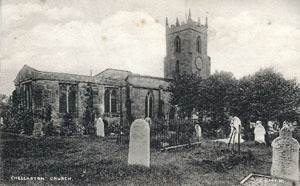
Methodism
Methodism came to Chellaston in about 1812 when a Mr W. Astle asked that his house, situated in Chellaston, may be used for public worship by those dissenting from the Church of England.
Chapel in Chapel Lane – built in 1816
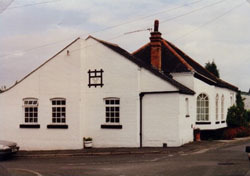
High Street – built in 1876

In 1816 a chapel was built in Chapel Lane. This is now a private house. The 1816 building was used until 1876, when a new chapel was built in the High Street. Worship takes place there each Sunday.
Baptists
The Baptist Chapel and the same location in the late 20th century (Derby Road/Parkway junction)
In 1868 Chellaston Baptist Chapel was opened on Derby Road but this disappeared with the building of the Parkway estate in the late 1970s.


Catholics
After worshipping at the Chellaston Golden Hour club on Maple Drive the opportunity came for the Catholics to open their own Chapel of Ease in the village. In 1971 the St. Ralph Sherwin Roman Catholic Centre on Swarkestone Road opened. This closed in January 2019 and has now been demolished to make way for a supermarket. It is believed a new place of worship will be re-sited nearby.
St Ralph Sherwin Catholic Church
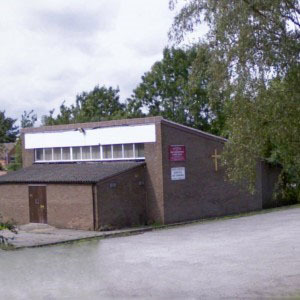
Alabaster
During the medieval period Chellaston became known worldwide for the quality of the alabaster mined in the area to produce monuments, tombs and tablets for churches etc.
The mines were mainly in the area between Chellaston and the neighbouring village of Aston on Trent and they ceased producing alabaster in the early 20th century.
Workers at an Alabaster Mine in the area
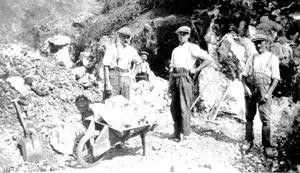
Education
Following the 1870 Education Act the Board School was opened in 1878 in School Lane, the building is still part of the Infants school today.
Children attended this school for the whole of their school life. Eventually, in 1967, a junior school was built on the Flatts and in 1977 Chellaston Senior School (now Chellaston Academy) was opened.
Another primary school (Homefields) was opened on Parkway in 2001.
A further primary school, Chellaston Fields Spencer Academy on Riber Drive is due to open in September 2019.
School photograph - 1941
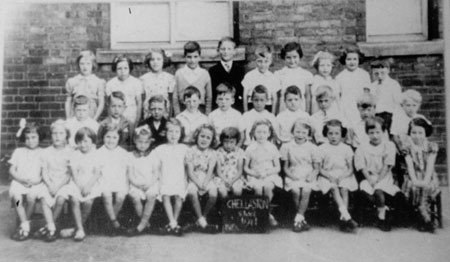
Hotels / Public Houses
There are, at the moment (January 2019), three public houses in Chellaston open and two closed. R&R's Sports Bar, The Bonnie Prince and The Lawns, ( a hotel with accommodation.) The Corner Pin (formerly the New Inn) is now closed but due to re-open this year. The Rose and Crown closed in January, 2019 and has been demolished to make way for a supermarket’s car park.
The Corner Pin is partly an 19th century building (although it is attached to an earlier cruck building which has been integrated into the main structure.) This public house closed early in 2016 was reopened by August 2016. It is now closed and boarded up (January 2019.)
Corner Pin
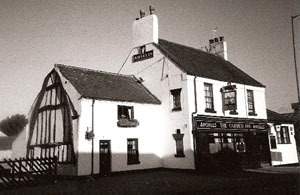
The Rose and Crown was almost certainly the oldest Chellaston public house. It was originally thatched and although much altered if you looked closely it was a far older building.
This building was subject to a planning application to demolish it and replace with a supermarket which was granted in 2018. It closed in January 2019 and has now been demolished.
The Rose and Crown in the 1950s
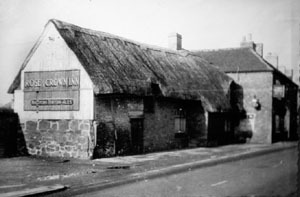
The Lawns was converted from a Victorian villa (The Lawn) into a hotel/public house (The Lawns) in the mid to late 1900s.
The Lawn as a Victorian Villa

The Lawns - 2016
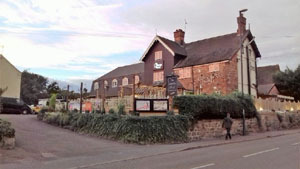
In March 2010, after a closure of approximately a year, The Lawns re-opened under new management and now has a restaurant area, and two bar areas with television in which food can be served. There is also a function room which caters for weddings etc. Overnight accommodation can be found here.
The Bonnie Prince was converted in the late 1990s from a Victorian residence (Holme Leigh) and has also recently been refurbished. Meals are served here and it has a children’s play area.
Bonnie Prince - 2011
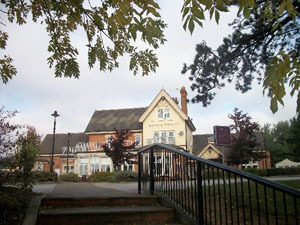
There is also the popular R & R Sports Bar and Lounge, with a bar downstairs and lounge-style room upstairs, previously the Chellaston Club, and before that a Royal British Legion social club.
This building was also a Victorian villa called The Hollies. The occupant in 1911 was Henry Fowler (later Sir Henry Fowler), Chief Mechanical Engineer of the Midland Railway.
Chellaston Club - 2011

Another public house was the Red Lion which originally dated from c1829. This was demolished in August 1963 and a new pub built on the site of the gardens.
This public house closed in the 2000s and remained empty for a couple of years. It was eventually converted into a Tesco supermarket.
The Two Red Lions before demolition of the original one
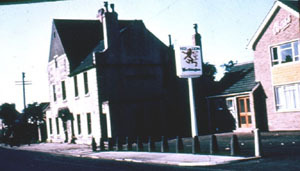
Canal
In 1796 the Derby Canal opened, running through west Chellaston linking the Trent and Mersey Canal with Derby. The canal closed in the mid 20th century but there are now plans to re-open it.
Canal at Shelton Lock in the 1950s
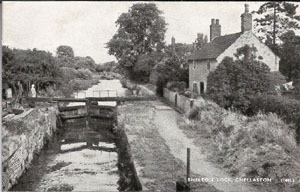
Turnpike
The road through Chellaston became a turnpike (toll road) in 1856. The toll house stood at the roadside, approximately where the bus stop in front of the chemist’s shop is now.
Chellaston Toll House

Railway
The Midland Railway opened the Derby-Melbourne branch in 1868, eventually extending to Worthington, Weston on Trent and Stenson.
There was a railway station at the bottom of Station Road which closed in 1930 and after that the branch line operated solely as a freight line, eventually this ceased about 1966.
Chellaston and Swarkestone Station

Today Chellaston is a rapidly expanding suburban village within the City of Derby.
1 note
·
View note
Photo

Best Things to do in Yellowstone National Park (Part 2)
Best Things to do in Yellowstone National Park (Part 2): With a history spanning millions of years and geology that will awe and inspire even the most unimpressionable visitor, the areas of Yellowstone's Grand Canyon and Lower Yellowstone River will leave you breathless – both literally and figuratively! My name is Rob Decker and I'm a photographer and graphic artist with a single great passion for America's National Parks! There is so much to see and do throughout Yellowstone, it's easy to get overwhelmed – best to take it in stages. This Part 2 article in our 3-part Yellowstone National Park series focuses on the Grand Canyon and lower parts of the park. Yellowstone's Grand Canyon This area should be top-of-the-list for any visitor to Yellowstone for one simple reason: The Grand Canyon of the Yellowstone. If one were to fly high above, what may seem like a loose seam in the fabric of the Earth is actually a 20-mile-long split – a gorge that plummets from a sheer-sided fissure more than 1,000 feet down to the Yellowstone River. In certain places, it widens up to 4,000 feet. Two thundering waterfalls punctuate the river's flow in a palette of bright yellows, oranges, reds, whites, and browns swirling across the rocky depths. A whopping 63,500 gallons of water per second runs through these falls at its peak, then gradually drops to as low as 5,000 gallons per second come late fall. It's no wonder this area has been the muse of countless artists over the decades. And while this canyon is not nearly as big as the one in Arizona, it is just as impressive. Several miles of hiking trails connect 10 major overlooks, affording dramatic views from both sides of the canyon. Lower Falls of the Yellowstone River The lower falls owe their existence to bands of hard volcanic rock. These bands did not erode as quickly as the surrounding softer stuff; consequently, the more resistant spots formed dramatic drops over which the raging river plummets, with dramatic effect. The colors continue throughout, made possible by the minerals taking up residence in the rock, such as iron in the rhyolite. Different layers of rock are exposed, and varying stages of oxidation transform the surrounding cliffs into wonderful hues. The trail hiking in this area is amazing. The Brink of Lower Falls Trail in the North Rim, in particular, offers a gorgeous vantage point and a peek at the 109-foot Upper Falls near the top. While this is a short mile-long hike and paved, it does dip 600 feet to a precarious perch above a 308-foot waterfall. Alternatively, Lookout Point offers a wider perspective of the Lower Falls, and you may just get a glimpse at an osprey nesting site! Continue down to the Red Rock Trail – a boardwalk staircase going down 500 feet deep into the canyon. Here, the Grand View Overlook points downstream for a kaleidoscope view of vibrant canyon colors. The last view on this trail is Inspiration Point, giving an astounding glimpse of the Lower Falls and the canyon downstream. Drive to the South Rim, and you can access Uncle Tom's Trail; a steep, switch-backing route consisting of a steel staircase bolted right into the side of the canyon. Back in the day, this trail was nothing more than a rope ladder. For something a little easier, take 1.3-mile Point Sublime Trail. Follow the South Rim Trail beyond Artist Point to this less-traveled path, which meanders along the canyon rim. Conversely, for those seeking something more strenuous, the Seven Mile Hole Trail is the only one that leads to the canyon bottom. You'll want to commit an entire day to this incredible hike, at just over 10 miles round trip. You'll also want to pack a picnic lunch and stop frequently along the way just to admire the views. Several of these canyon trails were originally built in the 1930's and efforts are underway to rehabilitate some of them with support from Yellowstone Forever. Due to unforgiving weather, soil erosion, and increased visitation, they have been hammered over the years and the park is dedicated to maintaining the safety and beauty of these trails. Mount Washburn For a great day-hike just a few miles north of Canyon Village, Mount Washburn is the result of volcanic activity that took place long before the formation of today's canyon. Named after General Henry Washburn, who was a leader of the 1870 Washburn-Langford-Doane Expedition, the mountain stretches up to 10,243 feet (3,107 meters) and has panoramic views at the summit for up to 50 miles on a clear day. While at the top, don't miss out on interpretive exhibits. The mountain is one of three fire lookout stations in Yellowstone and is fully staffed with park rangers watching for signs of fire all throughout fire season from about mid-June through early autumn. View Wildlife in Hayden Valley Hayden Valley is located six miles north of Fishing Bridge Junction. Hayden Valley offers some of the best habitat in the lower 48 states for viewing wildlife like grizzly bears, bison, and elk. Hayden Valley was once filled by an arm of Yellowstone Lake and it contains fine-grained lake sediments that are now covered with glacial till left from the most recent glacial retreat, about 13,000 years ago. Because the glacial till contains many different grain sizes, including clay and a thin layer of lake sediments, water cannot percolate readily into the ground. This is why Hayden Valley is marshy and has little encroachment of trees. Stay tuned for the next installment of Best Things to do in Yellowstone National Park! Canyon Village This area of Yellowstone provides the perfect base for exploring the canyon. The village could be considered a small town unto itself; a sprawling development with lodging, dining options, a general store, a campground, and the Canyon Visitor Education Center. The Canyon Lodge and Cabins are probably the most centrally located within Yellowstone, for easy travels north to popular spots like Mammoth Hot Springs and Lamar Valley, as well as points south and west. Canyon Visitor Education Center Located in Canyon Village, this is a great place for an introduction to your upcoming adventures. It was part of the Mission 66 project, a 10-year effort intended to expand Park Service visitor services by 1966 in time for the 50th anniversary of the establishment of the Park Service. Learn about the geology, history, and wildlife of Yellowstone's Grand Canyon. Also, learn about Yellowstone's supervolcano and how it affects the landscape. Check out the 9,000-pound rotating “kugel ball” that illustrates global volcanic hotspots, along with the world's largest lava lamp! View exhibits, a 3D map, and see reenactments of the major eruption at Yellowstone 640,000 years ago. Watch an informative film in the theatre, and listen in as rangers give real-time information about park happenings. Click here to see the Lower Falls poster. Rob Decker is a photographer and graphic artist with a single passion for our National Parks! Rob is on a journey to explore and photograph each of our national parks and to create WPA-style posters to celebrate the amazing landscapes, vibrant culture and rich history that embody America's Best Idea! Click here to read more about Yellowstone's Geyser Basin and Old Faithful! https://national-park-posters.com/blogs/national-park-posters/best-things-to-do-in-yellowstone-national-park-part-2?utm_source=rss&utm_medium=Sendible&utm_campaign=RSS
0 notes
Link
Discover Hand Made Ornaments from Germany
If you’re looking for Santa’s toy shop, don’t go to the North Pole. Head to a small village in the Erzgebirge Mountains of Germany. In this small village, the craft of toy making has become a tradition that has endured for centuries.
In this mountain village, small workshops produce some of the finest German Christmas ornaments. You can find everything from traditional Santas and nutcrackers to snowmen on skis and the amazing tiered nativity pyramids.
How Seiffen Became a Toy Paradise
Seiffen is in the eastern German province of Saxony on the Czech border. It has a population of about 3000 people. The name Erzgebirge means “ore” in German, and mining was an important industry for much of Seiffen’s history. Miners pulled tin, iron and other metals from the mountains surrounding the village.
Mining contributed to Saxony’s growth as one of Germany’s most economically and historically important regions. In the 1600s, residents looked for new ways to make money that would be safer than going into the mines.
These Woodworkers Preserve an Important Folk Art
They turned to toy making and soon became known for their beautifully designed German Christmas ornaments. Toy making was a big industry in Germany, and German Christmas decorations were considered the finest in the world.
In 1699, Seiffen resident Johann Friedrich Hiemann took toys from Seiffen to the huge Nuremberg toy market. They were an instant success. Ever since, hand made ornaments have brought prosperity and fame to Seiffen.
Today, this region of Saxony preserves the German tradition of handcrafted wooden toys. Most of the workshops are family-owned businesses that have been in operation for several generations. Around 150 full-time and 800 part-time woodcarvers now work to produce these beautiful ornaments.
Seiffen Is the Home of Germany’s Most Famous Nutcrackers
Wilhelm Friedrich Füchtner was born in Seiffen. He came from a family of carpenters, and he wanted to give them steady, year-round work. He developed a way to produce large numbers of toys using a water-powered lathe.
In 1870, he began making the wooden nutcrackers that later became immortalized in Tchaikovsky’s Nutcracker Suite. He became known as the “Father of the Nutcracker.” Today, Fuchtner’s workshop is still in its original location in Seiffen, and the Fuchtner family still operates it.
After World War II, Saxony became part of East Germany. After reunification in 1989, the world became acquainted with the wonderful toys that came from this picturesque mountain village.
What Makes Seiffen’s Toys Special
Old-fashioned hand crafting is the heart of Seiffen’s beautiful wooden toys. The skilled toy makers use some modern techniques but largely stick to hand turning and shaping. Artists carefully paint every face and every detail by hand.
Seiffen’s toy makers are experts at sawing, shaping, wood turning, carving, carpentry and painting. They use special techniques to create each toy. One of these is Reifendrehen or “ring turning,” which involves spinning a hollow section of wood on a lathe, etching it and then slicing it into the desired shape.
Many Famous German Christmas Ornaments Originated in Seiffen
Seiffen woodworkers created the wooden folk art known as “span trees.” These are wooden trees made by slicing tiny, delicate curls into a piece of pointed wood. Families who practice this craft have been doing it this way since 1930. The process to make them is called Spanbaumstecherei in German.
Seiffen toy makers were the first to design the wooden display pyramids that many people associate with Christmas in Germany.
Seiffen’s mining history is evident in many toy designs. Wooden miners remain the most popular Seiffen items. The miners carry bright yellow lamps like the ones Seiffen’s original miners carried into the mines every day.
Seiffen Makes Smokers and Other Hand Made Ornaments
Seiffen woodworkers invented the toys known as “smoke men” or smokers. These are toys that double as incense burners. Known as Räuchermann in German, the smoker is an indispensable part of most German families’ Christmas decorations.
Each smoker contains a hidden compartment. The toy maker places a small metal cup inside this compartment. To make it smoke, you light a tiny piece of incense that smolders without burning. This creates fragrant, long-lasting smoke that comes out of the figure’s pipe.
The original smokers were almost always figurines of miners. Today, you can find smoking Santas, cats, dogs, snowmen, motorcycles, cars and boats.
Seiffen Toy Makers Have Unique Styles
Most workshops in Seiffen specialize in a particular type of ornament or decoration. The Rudolph family, for instance, focuses on span trees. Martina Rudolph learned the craft from her father and passed the tradition onto her own family.
Klaus Merten specializes in smokers. He was inspired by the work of Gotthelf Friedrich Haustein, who created the first smoking men in the 1850s. After Haustein’s family stopped making toys, Merten’s workshop became the premier producer of these traditional ornaments.
Candle Arches Illuminate the Holidays
Candle arches are another famous product from Seiffen’s workshops. Known as Schwibbogen in German, these curved, decorated wooden candle holders add a beautiful touch to any Christmas display.
Like the smokers, candle arches recall Seiffen’s mining history. The miners usually began their Christmas celebrations after completing their last shift on Christmas Eve. These miners crafted makeshift candle holders out of curved pieces of metal.
Many homes and shops in Seiffen display wooden candle arches in their windows during the holiday season.
Nativity Pyramids Are Traditional German Christmas Decorations
You may be familiar with German nativity pyramids. These spectacular display stands are big sellers at most German Christmas markets.
Each pyramid features one or more tiers. There is always a classic nativity scene depicting Joseph, Mary and the baby Jesus. The other tiers hold wooden figurines depicting the shepherds, barn animals, wise men, villagers and other figures. At the top is a tier of singing angels.
German candle pyramids are works of art and engineering. These pyramids have an internal mechanism that allows them to spin around. The toy makers place small candle holders at each corner of the pyramid. The top tier includes a rotor with blades. When you place candles in the holders and light them, the warm air causes the rotor to gently spin the tiers.
With a candle pyramid, you can watch the tiers spinning around as you admire the wonderful artistry of each item.
Seiffen Keeps Germany’s Folk Art Traditions Alive
Germany is famous for its Christmas stores, and Seiffen is at the top of many visitors’ list. The village gets almost half a million tourists each year. Visitors enjoy the opportunity to wander around a snowy village, eat holiday treats and buy traditional German Christmas decorations.
To keep the tradition alive for future generations, the Seiffen Toy Makers Guild operates a training college with its own workshop. The school owns a dozen professional lathes and work benches where students learn the details of woodworking and making toys. It takes three years to complete the training. About 25 students train each year.
The profession of wooden toy maker, or Holzspielzeugmacher in German, is now officially listed in Germany’s national Crafts and Trade Code of professions.
Find Gorgeous German Ornaments at Schmidt Christmas Market
At Schmidt Christmas Market, we are proud to carry nativity pyramids and other handcrafted German items. You can see the fine detailing that goes into every beautiful ornament.
Seiffen wooden toys are ideal for anyone who collects folk art, Christmas decorations or German crafts. We import these finely made items directly from small, family-owned workshops. These wonderful works of folk art are ready to make your Christmas memorable.
0 notes
Text
Guest Post: How to Date a Rowhouse (Other Than Swiping Right)
By Jackson Gilman-Forlini
Let’s say you’re looking to buy a house and you’re searching through a certain real estate website (ahem). You see a beautiful rowhouse for sale and it’s exactly what you’re looking for. You ask the seller for more information but she doesn’t really know anything about its history.
Of course, that’s not a problem because you read McMansion Hell and so you already know the house’s age and what kind of people used to live there.
In Part I of this series, we looked at the development of rowhouses from the exterior and why they are so successful. This week, we’ll examine interiors and how you can identify the different types of rowhouses when observing them in their natural environment. Your friends will be amazed!
What kind of rowhouse is it?
Because of the immense adaptability of rowhouse design, several parallel modes of categorization and identification could be employed. The most common system is to identify the rowhouse based on the architectural style of its ornament. This has some advantages because style is relatively easy to identify and helps to approximate the age of the house.
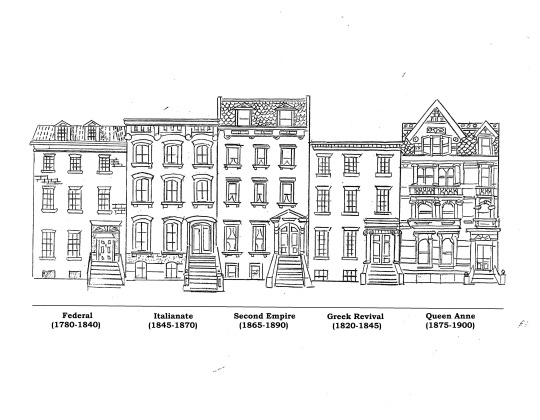
Common 19th century architectural styles and decades of construction. [Drawing by the author based on an original by The Old House Journal]
However, architectural style alone is somewhat limiting as an identifier because rowhouses are defined by certain structural elements such as size and roof type. Facade material is also very important when categorizing rowhouses. This is particularly true for rowhouses covered with brown sandstone or “brownstone.”
This type of facade is so common that the term “brownstone” has become yet another synonymous word for rowhouse- even those without brownstone on the facade. Finally, regional variations on the rowhouse have meant that individual cities display rowhouses with characteristics specific to that city, thus creating yet another potential system of taxonomy.
Taking all this together, I’ve arrived at a handy chart to combine these 4 systems of categorization. When describing and identifying a rowhouse, each column in the chart could be used independently or together with one or more of the other columns:

For the purposes of this article, we will focus on the interiors of rowhouses by looking at what floor plans can tell us about the age of rowhouses and the people who lived in them.
Floor Plans
As has been discussed in an earlier edition of “Looking Around,” floor plans are often a better way of categorizing vernacular architecture than trying to identify the style of the ornament.
When it comes to rowhouses built before 1915, there are essentially two different basic types of floor plans- those with a front hall and those without a front hall. Within these two types, there exist dozens of variations but they all come back to the hall as a distinguishing characteristic.
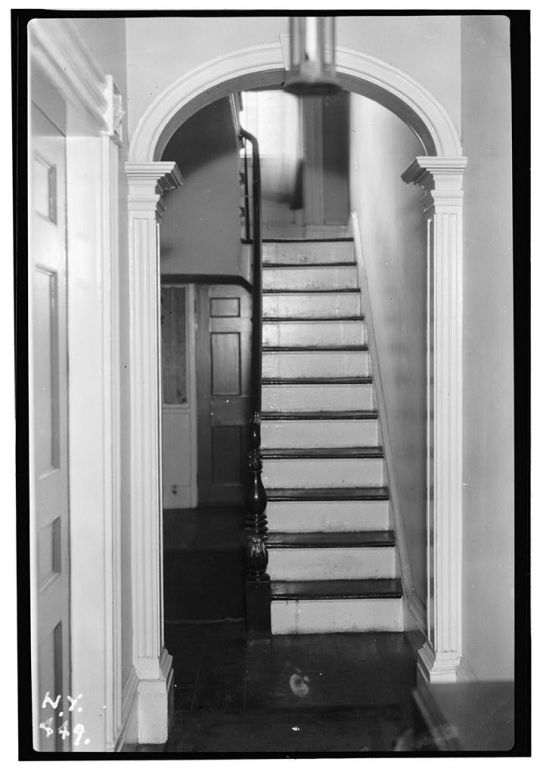
Front hall at 4 Grove Street, New York, NY (Built circa 1829) [Source: Historic American Buildings Survey, Survey No. NY-449, Public Domain]
A seemingly simple and narrow space, the hall serves multiple roles. Architecturally, it provides a passage so that inhabitants do not need to cross through intermediary rooms while moving to different parts of the house. Due to the narrowness of rowhouses, horizontal space is at a premium and lateral movement is a luxury. The hall allows for lateral movement with maximum efficiency of space. It also allows for a straight staircase, thus allowing for more visually appealing stairs that are also physically safer to use than those that wrap around.
In the 19th century, the hall additionally served the very important social function of intermediary space between the outside world and the domestic interior. The hall was the first thing that visitors would see upon entering the house and so it was often impressively decorated with architectural features and furniture. The hall was the place where visitors could be kept while waiting to be admitted to the inner portions of the home. This provided privacy for the inhabitants and later reinforced conservative Victorian ideas about formality and familiarity.
Therefore, the hall represents a division between sophisticated designs and more basic ones. Not surprisingly then, the presence of a hall (and its size) signifies the relative wealth of the rowhouse’s original inhabitants. You know what they say about people with big halls, right?
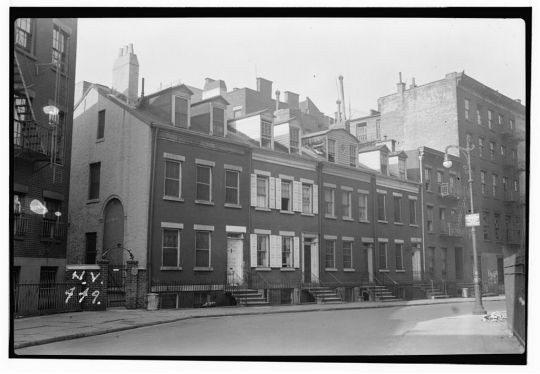
Exterior of 4-10 Grove Street, New York, NY, built c. 1829, as it appeared in 1936 [Source: Historic American Buildings Survey, Survey No. NY-449, Public Domain]
A good example of a rowhouse hall can be found at 4 Grove Street in Manhattan, built circa 1829. Typical of rowhouses of this period, the first floor is divided between a “front parlor” and a “back parlor” with the hall running along both. During the Victorian period, both parlors were used for entertaining guests. The front parlor later became what we call today the living room while the back parlor later assumed the role of dining room. Bedrooms on the second floor follow a similar layout.
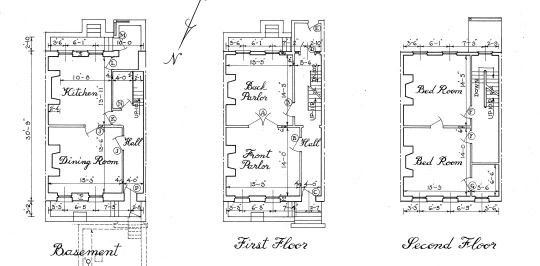
Interior of 4 Grove Street. [Source: Historic American Buildings Survey, Survey No. NY-449, Public Domain]
In the floorplan above, note the placement of the hall in relation to the other rooms. It allows someone to move front to back and side to side within the house while maintaining a reasonable width for the main living spaces. You’ll notice that the kitchen and dining room were placed in the basement for maximum space efficiency. Fans of “Downton Abbey” know that among wealthier households, putting the kitchen in the basement was also a convenient way of hiding servants and their workspace out of sight. In many upper class homes, a second, smaller staircase known as a “servant’s stair” allowed for the discrete movement of servants between floors.
Naturally, rowhouses for the working class were smaller than their more affluent counterparts. Among these smaller rowhouses, the reduced size of the overall plan necessitated reducing the size of the hall or eliminating it altogether. Without domestic servants, working class homes also moved the kitchen out of the basement and into an extension on the rear. This new location on the back of the house was as much for convenience as it was for fire safety. Keeping flames segregated to the back of the house made fires easier to contain should they break out.

Early 19th Century Working Class Rowhouses and Floor Plans [Source: Historic American Buildings Survey, No. MD-932, Public Domain]
The example on the left depicts a very common floor plan for a working class rowhouse. The front entrance opens directly into the front parlor (or living room) which then had to be crossed to enter into the back parlor, or dining room. A small winding staircase is tucked into a closet and the kitchen sits in an extension on the rear.
The rowhouse on the right demonstrates an intermediary design. The exterior has three stories, thus signifying a more affluent original owner, but is not as wide as upper class homes like 4 Grove Street. The middling character of the exterior also extends to the floor plan on the interior. By the addition of a wall through the front parlor, the front door opens into a “quasi-hall.” This sort of half hall does not extend far enough to accommodate a straight staircase, but does provide some additional privacy. As with the example on the left, a third room in the rear of the house accommodates the kitchen resulting in a floor plan that is 1 room wide by 3 rooms deep.
By the late 19th century, almost all rowhouses followed this “1 x 3” pattern in some form. Therefore, other than size, the distinguishing feature between wealthier homes and modest ones was the presence or absence of a hall.

This floor plan of a Baltimore rowhouse is very typical of most working class rowhouses built from the end of the Civil War up to about 1915. This example was located at the end of the row so it was better lit than its neighbors, and therefore more expensive. The center room on the first floor was commonly used as a dining room. Porches, like the one seen here, began to appear in the 1870s and became increasingly common by 1900. In lieu of a hall, they took the role of intermediary space between indoors and outdoors. [Source: Historic American Buildings Survey, No. MD-1005, Public Domain]
The big problem with the “1 x 3” design is that it creates a “center room” in between the living room and the kitchen. This room is relatively dark and poorly ventilated compared to the other rooms in the house. After about 1915, this design was improved by rowhouse builders in response to growing market competition from outer suburban detached houses. By widening the house and creating a “2 x 2” floor plan where the kitchen was brought parallel with the center room, all rooms received an equal distribution of light and fresh air. The new floorplan also allowed for equal lateral and longitudinal movement throughout the house. This style of rowhouse became known as the “daylight rowhouse” and was a popular middle class housing type up until about 1930.

Built from 1915 up until the Great Depression, the “Daylight Rowhouse” represents a major advancement in rowhouse design. The addition of skylights over the stairway added additional natural light. Drawing by the author.
House construction pretty much ceased during the Great Depression, and rowhouses had fallen out of style once building picked up again after World War II. Consequently, there aren’t very many examples of rowhouses constructed between 1930 and 1990. Today, new rowhouses or townhouses are similar to older models in their appearance. Contemporary rowhouses tend to be a little bigger and a little taller to accommodate a garage on the ground level. The one major change to the rowhouse floor plan has been the introduction of the “open floor plan” where most interior walls on the first floor have been removed entirely. The living room bleeds into the dining room, which bleeds into the kitchen.
The popularity of the open floor plan has resulted in the removal of interior walls from many older rowhouses. If you find yourself in an old rowhouse with an open floor plan, then that means someone removed the original walls fairly recently. But if you are in a rowhouse with walls, then pay attention to how they are arranged because they can tell you a lot about the house’s history and who was there before you.
About the Author
Jackson Gilman-Forlini is a historic preservationist for the Baltimore City Department of General Services, where he coordinates the Historic Properties Program. He is a Masters candidate in Historic Preservation at Goucher College and can be reached at [email protected]
[Editor’s Note: That’s it for this installation of Looking Around! Next week: a New Hampshire McMansion and a primer on common architectural details. Special round of applause for Jackson for sharing his expertise on rowhouses, something I admittedly know much, much less about. Have a great week, everyone!]
#architecture#history#architectural history#looking around#rowhouses#townhouses#rowhouse#baltimore#brownstones#vernacular architecture#historic architecture#historic preservation#urbanism
968 notes
·
View notes
Text
Highgate Cemetery
Highgate Cemetery is one of the most haunted places in London, and with good reason. In the early 1800’s the city’s population topped the 1 million mark and, despite a high death rate, it was still growing. Graves were crammed between shops and outside taverns. Undertakers dressed up as clergymen to perform illegal ceremonies. Many people were buried in shallow graves and quickly covered with lime. The stench and disease were horrific.
Parliament decided that seven private cemeteries would be built in the countryside around London. (They were known as “The Magnificent Seven.”) The third cemetery, dated 1839, was Highgate. The architect and builder turned Highgate into an eternal oasis of peace. Everybody who was anybody wanted to be buried there. By 1854, the place was packed, and they bought another 20, adjoining acres.
By the turn of the 20th century, the cemetery’s fortunes waned. World War I decimated the staff, and by the end of World War II the cemetery had all but been abandoned. In 1960 the gates to Highgate Cemetery were closed, pristine landscaping become lush jungles, and buildings tumbled in on themselves. Studios used the grounds to shoot horror movies. And then the rumors and rituals began . . .
Stories of men dressed in dark robes, practicing dark rituals, surfaced. Ghosts and ghouls haunted the alleyways around the graveyard. People reported seeing red-eyed demons, staring at them through the fence.
And then there was the Highgate Vampire. The vampire was said to be a medieval nobleman who practiced black magic in Romania. His coffin was brought from Europe to England in the 18th century, and his cult-like followers bought him a house in the West End. He was buried at the site that eventually became Highgate Cemetery. He slumbered peacefully until, according to reports, Satanists performed a ritual at the cemetery. It woke him up.
The Highgate Vampire is said to be a tall, dark figure that glides through the cemetery. His presence is frequently announced by a sudden drop in temperature. He has also caused clocks and watches to stop. He terrifies all animals in his vicinity, and he’s been blamed for scores of dead foxes on the cemetery grounds. The Highgate Vampire has a hypnotic stare and bone-chilling effect on all who have encountered him, especially those foolish enough to spend the night in the cemetery.
The Highgate Vampire is just the tip of the supernatural iceberg. The problems with the dead started during Victorian times with exploding coffins. Highgate Cemetery has a series of tombs built for those who wanted to be buried above ground. Regulations at the time required tombs to be encased in lead to prevent “miasma” leaking out. As the bodies decomposed in their hermetically sealed tombs, the buildup of gases caused some coffins to explode.
The solution was to drill a small hole in the coffin, place a pipe in it, and then light a match so the gasses could burn off “hygienically.” Though the cemetery is done burning off gasses, there are still problems, including heart-stopping banshee wails. Spectral faces float around the place. A ghostly cyclist wanders the grounds, as does the floating ghost of a nun. Some spirits are such regular visitors that the locals have named them.
Today, 170,000 people are buried at Highgate Cemetery in 53,000 graves on 37 acres. Plots are still for sale, subject to government restrictions. It continues to be a popular place for enthusiasts of the occult, paranormal, and vampires. It also hosts the graves of some of history’s most well-known figures, including Karl Marx, Malcolm McLaren, and George Michael. On your London vacation, consider a tour of Highgate Cemetery!
highgate cemetery is located in the area of highgate London just 20 minutes north of the london city
center sprawling across a massive hill covering 37 acres the cemetery is supposedly one of the
most terrifying and haunted places in the world in the early 19th century london was at an
all-time high in population space was scarce along with an overflowing of living people there was also an overflow of dead people cemeteries were hard to come by the few that were there were filled to the brim with the deceased many places were reusing grave plots and burying multiple family members in one grave graves were shallow quicklime was used to decompose bodies so that new ones could be added space was running out cemeteries were being squeezed between restaurants and shops the smell was horrendous of rotting flesh and decay something had to be done this was no way to honor the dead
and no way to live parliament decreed that seven new cemeteries should be opened in the countryside just outside of London highgate cemetery was one of these seven and it was opened in 1839. parliament created the london cemetery company to build these cemeteries stephen geary architect and founder james bunstone bumming surveyor and david ramsey garden designer were assigned to highgate 17 acres of land that was once the ash hurst estate was purchased for 3500 pounds just downhill from the highgate village within three years the landscaping was meticulously designed and created using a huge variety of professional plants and pathways the architecture was beyond incredible using themes from other times monuments sculptures and tombs the cemetery was the most lavish place in london to be buried and soon became the most popular especially for the wealthy on monday may 20th 1839 the cemetery was dedicated to saint James by wright reverend charles James blumfield lord bishop of london in addition to the gravesites and monuments 15 acres were set aside for the church of england
and two acres for the others brights of burial were granted for a limited time or forever there were two chapels on the property done in tudor gothic style there were wooden turrets and a bell tower with an archway below it which led to the cemetery there were several architectural styles the central part just under the arch was egyptian avenue with 16 vaults lining a passageway on either side each vault had 12 coffins for each family circle of lebanon had 20 vaults in theinner circle and 16 vaults classical style that were added in the 1870s and the center was a cedar of lebanon tree that was there from the ashfurst estate above was the gothic style terrace catacombs built on the old terrace of ashhurst it held 825 dead total for the next 20 years highgate was the most desirable place to be buried in 1856 it was extended an additional 20 acres on the other side of swain's lane this was to be known as the east cemetery a tunnel went under swain's lane to the church on the west side this would allow for a hydraulic lift for coffins to descend under the church and for them to go into the tunnel the first burial on the east side was in 1860 by that time there were 10 400 graves onthe west side by the 1900s people were beginning to
lose interest in elaborate and expensive grave sites with extravagant memorials due to declining fortunes after world war ii some families still purchased select rights of burial into the 1930s but most were wanting simple and less expensive graves many ended up moving from the area and their family plots were left to waste away in the 1960s the london cemetery company went bankrupt and was taken over by united cemetery company this company had a hard time maintaining the grounds and eventually ran out of money and the cemetery was closed slowly the vegetation crept into the abandoned cemetery and grew over the gravestones memorials and elaborate monuments
in the 1970s hammer horror films were at their peak and they often used tie gate cemetery as the backdrop for many of their movies interest in the cemetery began to peak once again stories began to circulate about the strange happenings in the cemetery there were rumors of evil cults holding ceremonies after dark men in dark robes animals found with the blood drained from them many would write to the newspapers telling of their frightening experiences when man had his car break down by the cemetery he saw an apparition with glowing red eyes peering at him from behind the bars of the gates another man walking along swain's lane was thrown to the ground by a creature that glided from the cemetery wall a car's headlights flashed towards this being and it dissolved into thin air there was another story of a ghost bicyclist a mother was at the cemetery and she saw an apparition of a man
on a bike pedaling up the hill another story is that of the hat man he is tall with a top hat walking
casually across the road and vanishing into a wall when he walks people hear the chapel bells ringing
some people have seen an old woman ghost she is mad with long gray hair flowing behind her as she runs through the graveyard it is said she is looking for her children that she murdered when she was
still alive others have seen a shrouded figure who stares into the ethers not aware of being seen until people get very close and then the apparition disappears and then reappears a few meters away staring off into space sounds are heard in the cemetery banshee whales voices and bells spectral faces are seen
people claim to be physically assaulted by unseen hands there is also rumor to be a ghost nun and a woman in white at one point there were even exploding coffins originally for the vaults the coffins
were lined with lead so that they would not leak out the remains the gases would build up in these
coffins and eventually the pressure would cause them to explode they solved this problem by inserting
pipes into the coffins and the gas would escape and they would light the pipes and the gas would slowly burn off the most famous story however is that of the high gate vampire he was said to be a medieval nobleman a black magic practitioner from romania his coffin was brought to London to highgate from continental europe in the 1700s by his followers they also bought a house in the west end and buried him on the property there this area ended up being part of the highgate cemetery all was well and good until the satanists began performing rituals there this is according to sean manchester then supposedly
all hell broke loose and the vampire awoke from his deep sleep rumor has it that the vampire was very tall dark and floated smoothly across the cemetery grounds the air turns cold when he is near and clocks and watches stop animals are frightened of him and it is said that he is the one draining blood from the foxes his look is hypnotic and terrifying two men david farant and sean manchester who were very much into the occult were absolutely sure that this vampire was real and they were determined to exterminate the creature ferond had written to a newspaper claiming he had an experience with the king vampire a lot of publicity was focused on these men and their claims people grew to be very interested in the story about a vampire and followed the stories of fran and manchester with excitement the fervor of these men grew and they soon decided to take decisive action against the highgate vampire they organized a vampire hunt on march 13 1970 friday the 13th many people showed up with garlic wooden stakes and hatchets several people descended on the cemetery ripping up graves breaking open tombs and trampling the grounds they plunged wooden stakes into corpses decapitated many of them and even moved skeletal remains to strange places one man found a skeleton in the driver’s seat of his car the cemetery grounds were severely damaged and the vampire grave was never
to be found in 1975 the friends of the high gate cemetery was formed to conserve the cemetery land plants and animals so that the property could be visited and appreciated once again by the public and used actively for burials some of the overgrown foliage has been removed paths cleared and monuments repaired over the years there has been more and more restoration egyptian avenue the circle of lebanon
terrace catacomb and 70 other monuments have been listed with the english heritage some of the more well-known people buried here are karl marx sci-fi author douglas adams james holman a famous blind man that used vibrations to guide his way and adam worth possibly the inspiration for sherlock holmes’s nemesis professor moriarty the chapel was reopened in 2011 restored using original colors and it is currently used for funerals both the east and west sides are open as active burial sites currently there are 170 000 people laid to rest at highgate and 50 000 graves the cemetery is running out of space and talks are in progress about reusing some of the older graves the west side is still very overgrown and is only accessed by guided tours the east side is open to self-guided walks entrance fees are charged to maintain
and beautify the cemetery no video is allowed and tickets for the east side can be purchased online these are just some of the terrifying tales about the infamous highgate cemetery.
As we approach Halloween children and adults alike begin to prepare for the annual ritual of trick-or-treating but are there really such things as ghosts and vampires? Highgate Cemetery has always been referred to as haunted and in the past we have let an apartment in Holly Lodge Mansions which is behind the cemetery to a vampire enthusiast who wanted to be nearby. I have done some internet research into why people refer to Highgate Cemetery as haunted.
The Cemetery occupies 20 acres and is sprawled on the hilly slopes on the south side of Highgate Village. It was opened in 1839 and soon became a sought after burial spot amongst Victorians in London. By the early 20th century thousands of people had been laid to rest including many famous and illustrious names.
During the second world war the Cemetery saw a severe downturn and by the 1960’s it was pretty much abandoned. Rumours began to spread of cults holding strange ceremonies after dark in the abandoned ruins. The Hampstead & Highgate Express started to receive letters from frightened readers about ghostly experiences around the Cemetery. Apparently one man whose car had broken down was terrified by a hideous apparition with glowing red eyes staring at him through the gates whilst another man walking along Swains Lane was knocked down by a fearsome creature who came out from the wall of the cemetery. The headlights of an approaching car caused the creature to dissolve into thin air.
It was then suggested that a Vampire was living in the cemetery and it was bombarded by journalists, camera crews and curious people looking for the undead. The Highgate Vampire is rumoured to be a medieval nobleman who practised black magic in Romania. His coffin was relocated in the 18th century and buried on the site that became Highgate Cemetery. Apparently Satanists awoke him performing rituals. It is reported that he is a tall dark figure who glides around the Cemetery whose presence can be felt by a sudden drop in temperature. It’s also reported that watches and clocks have stopped working when he is near.
More letters of frightening encounters around Swains Lane were received by the local press including a ghostly cyclist riding up the steep slope of Swains Lane and a tall man in a top hat stroll across the road and disappear into the wall of the cemetery.
In the 1980’s the Friends of Highgate Cemetery began a massive restoration project clearing the pathways and uncovering the spectacular tombs that had been neglected for years. Today ghostly sightings are reduced to the ghost of a mad old woman. Her long grey hair blows behind her as she races amongst the graves looking for her children whom she is supposed to of murdered in a fit of rage. The other is of a figure who gazes into space paying no attention to anyone nearby. If you get to close it vanishes reappearing a short distance away still gazing into space.
Highgate Cemetery hold a number of events throughout the year along with tours of the West Cemetery. Daily entrance is available to the East Cemetery where Karl Marx is buried and you can roam freely around.
Sprawled across twenty grassy, hillside acres, and opened in 1839, Highgate Cemetery quickly became the most sought-after burial spot in London, and fashion-conscious Victorians wouldn’t be seen dead in any other burial ground. By the dawn of the 20th century, tens of thousands of people had been laid to rest in its hallowed ground, amongst them many famous and illustrious names. The monuments to the dead became ever more ambitious as families struggled desperately to outdo one another in providing more and more ostentatious resting places for their loved one’s.
But as the dark days of World War 11 descended upon the capital, the cemetery’s fortunes saw a severe downturn and, by the 1960’s, the once proud necropolis had been abandoned.
Decay and neglect crept unchecked amongst the tombs as the roots of advancing vegetation split apart the magnificent graves and left their twisted masonry sprawled across toppled columns.
Rumours were soon circulating of sinister cults holding strange ceremonies after dark in the abandoned ruins. The local newspaper, the Hampstead and Highgate Express, began to receive letters from frightened readers telling of ghostly encounters around the cemetery. One man, whose car had broken down, was terrified by a hideous apparition with glowing red eyes, glaring at him through the rusting iron gates. Another man walking along the darkly forbidding Swain’s Lane, found himself suddenly knocked to the ground by a fearsome creature that “seemed to glide” from the wall of the cemetery. He was only saved by the headlights of an approaching car that seemed to cause the “thing” to dissolve into thin air.
When it was subsequently suggested that a Vampire might be loose in the old cemetery, a veritable barrage of journalists, camera crews, eager occultists and the just plain curious, swarmed around the decaying and grim mausoleums, garlic and crucifixes at the ready, and the hunt for the un-dead was underway.
Meanwhile, more letters telling of frightening encounters in the vicinity of Swain’s Lane continued to grace the pages of the local press. A ghostly cyclist, puffing his way up the steep incline had scared the life out of a young mother, whilst other unfortunate locals had witnessed a tall man in a top hat who would stroll nonchalantly across the road and then disappear into the wall of the cemetery. His nebulous stroll was, they said, always accompanied by a mournful tolling from the bells in the old, disused chapel.
A massive restoration project in the 1980’s by the enthusiastic “Friends of Highgate Cemetery” went some way to reversing the neglect of the previous decades. As they cleared the pathways and uncovered, once more, many of the spectacular tombs the ghostly activity began to recede.
Today, spectral sightings are reduced to; the ghost of a mad old woman, whose long grey hair streams behind her as she races amongst the graves, searching for her children, whom she is supposed to have murdered in a fit of insane rage; and a shrouded figure who gazes pensively into space, seemingly oblivious to the presence of witnesses, unless they get too close, whereupon it vanishes, only to re-appear a short distance away, adopting the same meditative pose.
Bibliography:
Joolz Guides - London History Walks - Travel Films (2017). Highgate Cemetery and Pub Walk - London Walking Tour. YouTube. Available at: https://www.youtube.com/watch?v=ur3yuPOHZ_A [Accessed 7 Nov. 2020].
Authentic Vacations. (2018). Haunted Highgate Cemetery, London, England. [online] Available at: https://www.authenticvacations.com/the-haunted-history-of-highgate-cemetery/ [Accessed 7 Nov. 2020].
Taylor Gibbs. (n.d.). Is Highgate Cemetery Really Haunted! [online] Available at: https://www.taylorgibbs.co.uk/news/is-highgate-cemetery-really-haunted.html [Accessed 7 Nov. 2020].
Realms of the Otherworld (2020). Haunted Highgate Cemetery. YouTube. Available at: https://www.youtube.com/watch?v=6TGIB3eFbok [Accessed 7 Nov. 2020].
www.haunted-london.com. (n.d.). London’s Haunted Graveyards:-Haunted Graveyards. [online] Available at: http://www.haunted-london.com/london-graveyards.html [Accessed 7 Nov. 2020].
1 note
·
View note
Photo


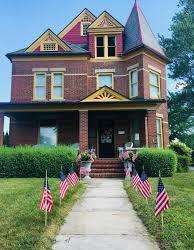
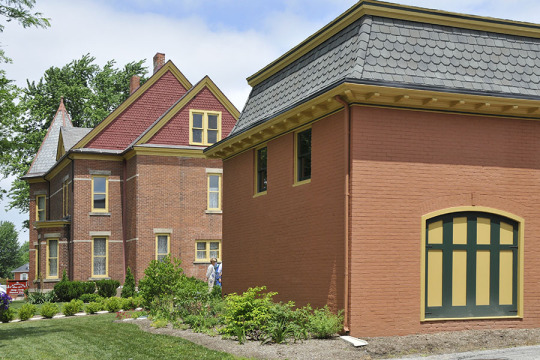
Henry County Historical Society
Dr. John Bloomfield Home
229 W. Clinton St.
Napoleon, OH 43545
The Henry County Historical Society was formed in 1970 to protect, preserve, and perpetuate the history of Henry County, Ohio, to learn about and preserve the artifacts of the county, and to generate interest in the past of the county. Today the HCHS operates two historic museum sites in Napoleon, Ohio. The HCHS’s primary location is the beautiful Victorian Queen Anne style Dr. John Bloomfield Home and Carriage House Museum located at 229 W. Clinton St. in historic downtown Napoleon, Ohio, across from the Napoleon Public Library. The Home was built in 1894, has been totally restored, and serves as the main museum for the HCHS. The Home, built by Dr. John and Susan Bloomfield is a Queen Anne Victorian era home and has lovingly been restored to its former glory by dedicated HCHS volunteers and community members.
The exterior of the home features three rising sun motifs. This rising or setting sun motif was common in many Federation-style homes from 1880-1915. Though the Bloomfield Home is not a true Federation home it is a combination of Federation and Queen Anne styles. There are two theories on rising sun or setting sun motifs and what they represent. The first possible option is it represented new dawn and an optimistic future as the United States was beginning to grow rapidly during the 1870s-1900. Immigration, the Industrial Revolution, and booming downtowns and cities were moving towards their peek when Dr. Bloomfield built this home in 1894. The second suggestion is the setting suns represented the waning power of England or the British crown.
Each sun appears in the center of a gable. A gable is the part of a wall that encloses the end of a pitched roof. There are four gables on the front of the Bloomfield Home. Gables create a multitiered roofline and break up straight roof lines giving the appearance of a multi-floored castle-like home with many floors. In actuality, the Bloomfield Home is just two floors with an attic. On the right side of the house is a tower. Not a turret. A turret is a small tower that projects vertically from the wall of a building such as a medieval castle. On the Bloomfield Home, the tower begins on the first floor and goes up through the second floor and is capped with a tent-shaped roof and finished off with slate shingles and a copper finial ornament.
Another unique and important detail is the variation of brick on just the front and sides of the house. Note a single stack of lighter sandstone tan wraps around the front of the home and tower breaking up the solid red brick of the home. This simple yet sleek band of varying colors provides contrasting details in the masonry work. Architectural details are highlighted on the Bloomfield Home with dark vivid colors and contrasting hues; oranges in the brick, reds, maroons, and tans are all dominant colors. The walls of a Queen Anne house maybe painted one color, while doors, window sashes, trim, and decorative shingles are painted in other colors; five separate colors can be painted on a single house. For the Bloomfield’s a rich mustard yellow coats all the wood trim on its exterior, with coordinating maroon on the peaks of the roof.
Inside the home the first and second floors boast their original hardwood floors, woodwork, and detailed doors, metal work, and one beautiful original stained glass window in the parlor. Pine, cherry, and oak are the most popular woods used throughout the house. The first and second floor of the home are open for tours and special events. When you come to the Bloomfield’s, period furnishings from the mid 1800s through 1930s fill the home as well as artifacts and collections from Napoleon and Henry County history. Some objects of interest include original photos of downtown Napoleon, furniture from the Rettig family dating to the 1860s, beautiful artwork from various local artists including Eldor Gathman. Larger collections include our textiles and clothing, fine china, silver, and military uniforms and personal affects.
The Dr. John Bloomfield Home and Carriage House Museum was donated to the HCHS by John “Ben” and Graceann Heller Reese in 2001. At the time of the donation the home had fallen into disrepair and had considerable water damage among many other issues. The HCHS agreed that it would restore the property to its original appearance both inside and out and that the home would serve and function as a home museum for Napoleon and Henry County, Ohio. Today the property is owned and maintained by the HCHS which is a 501c3 non-profit organization. Located directly behind the main home is the Carriage House. This museum space was restored in 2009 and holds a large collection of Henry County artifacts. This museum space currently features our newest exhibit Prohibition the Experience!
Throughout the property various modern and Victorian era gardens can be viewed daily. Various roses, hydrangea bushes, ferns, and flower varieties will delight both your eyes and nose. The Dr. John Bloomfield Home and Carriage House Museum is open free of charge to the public, the first Sunday of the month, May through October, with special events scheduled through the year. The Christmas Open House is a favorite! The home is also available for rentals including baby showers, bridal showers, teas, luncheons, and dinners.
The society also maintains the Henry County Historic Complex at the Henry County Fairgrounds. This site contains several historic buildings and structures include the Nathaniel Hartman Log Home c. 1860-1866, the 1897 Emmanuel Lutheran One Room Schoolhouse and Museum, the Ag Building, Smokehouse, and the c. 1910 Historic Gazebo. All of the HCHS facilities have been restored to their near-original appearance and house large collections of period furnishings, textiles, china, silver, and more dating from the early 1800s through the 1930s.
1 note
·
View note